THE TRINITY VOICE CULTURE FEST
Students and their families gather to celebrate diversity in the annual Culture Fest on Feb. 22, featuring 3O countries.




NEWS OPINIONS FOCUS
If passed, this Florida bill will ban kids under 14 from social media.
PRO/CON:
A
LIFESTYLES
SPORTS
Spring sports season has sprung. Check out the photo exposition dedicated to spring athletes.
to
Should states be allowed
take Donald Trump o the ballot?
definitive ranking of the top four romantic comedies ever made!
Page 29 Page 25 Page 19 Page 8-9 Gen Z is unsatisfied with the prospective political candidates. Page 6-7 March 2O24 Volume 26 Issue 5 Trinity Preparatory School 57OO Trinity Prep Lane Winter Park, FL 32792







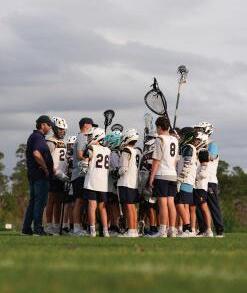
e Trinity Voice is a member of the Florida Scholastic Press Association and the National Scholastic Press Association.
e Trinity Voice is produced by the newspaper/journalism class at Trinity Preparatory School of Florida. Editorials represent the opinion of e Trinity Voice writer and are not necessarily the views of the administration, faculty, or Board of Trustees of Trinity. e Voice welcomes letters to the editor and freelance articles or photography. All submissions become the property of e Voice. Please send all correspondence to 5700 Trinity Prep Lane, FL 32792. e Voice may also be contacted via phone at 407-671-4140 and via e-mail at voice@trinityprep.org. For information regarding the purchase of advertising within e Voice, contact us by one of the methods mentioned above. The Voice is a monthly publication during the school year (with the exceptions of November and January).





CONTENTS March 2O24 Table of Contents
TABLE OF
VOICE@TRINITYPREP.ORG THETRINITYVOICE.COM @TRINITY_VOICE @THETRINITYVOICE “THE TRINITY VOICE”
News News Bites O4 O5 Play-ing with Physics Opinions O8 Social Media & Personality 14 Page 29 Jackson Napier Focus Cover Page TikTok Songs Removed 18 17 Hawaii Tourism Hartung Tennis Recruit
31 Rom-Com Rankings 19 In-School Gaming 2O
Kortman Cover Page
Sports Photos Pro: Trump on Ballot Lifestyles Rise of Consumerism Unsatisfied Voters Studio Ghibli Review Autistic Students O6-O7 Social Media Ban Bill Con: Trump on Ballot O9 Parental Advisory 1O-11 Commodity Fetishism 12-13 Feminist Trends 21 Lead Ed 15 16 Ads 22-23 24 25 26 28 27 29 Ads 3O
Sports
Puzzle
Olivia
Spring
Editor-in-Chief: Taylor Riley
Managing Editors: David Steinberg, Karthik Stead, Carol Marques, Peyton Alch
Layout Editors: Peyton Alch, Lucy Chong
Saint Talk
This Month’s Podcast:




Ep. 6 - Spotlight on the Social Media Stop STAFF
News Department: Zach Kleiman (Editor), Aarav Gupta, Sebastian Cabeza, Sofia Haddadin, Emily Lopez-Couto
Opinions Department: Amanda Rose DeStefano (Editor), Sammy Lou, Nikhil Daniel
Focus Department: Fay Zhao (Editor), Taylor Gri th, Mia Prince, Mila Taylor
Lifestyles Department: Laziza Talipova (Editor), Iris Lei, Jack Aaron, Tavish Ward
Sports Department: David Hull (Editor), Rahul Sivakumaran, Angel Berreondo, Olivia Agnew
Podcast Department: Mohil Kapadia (Editor), Gustavo Membreno, Nikhil Daniel,
Social Media Online Department: David Bryskin (Editor), Julian Sealy, Ana Herrera
Graphics Department: Caden Liu (Editor), Lia Garibay, Maxi de la Fuente, Sam Miller
Photo Department: Olivia Prince, Olivia Kortman (Editors), Ella Eichenholz, Jack Napier
Fact Checking Editor: Jack Aaron
Copy Editor: Sammy Lou
Business Manager: Iris Lei
Adviser: Erin Miller
What if social media was taken out of your life? For students 14 and under, this could soon be a reality. Tune in as writer Sofia Haddadin dives into HB-1, the social mediaban bill that could be in e ect as soon as July. Read her companion article on pages 6-7 for more information.
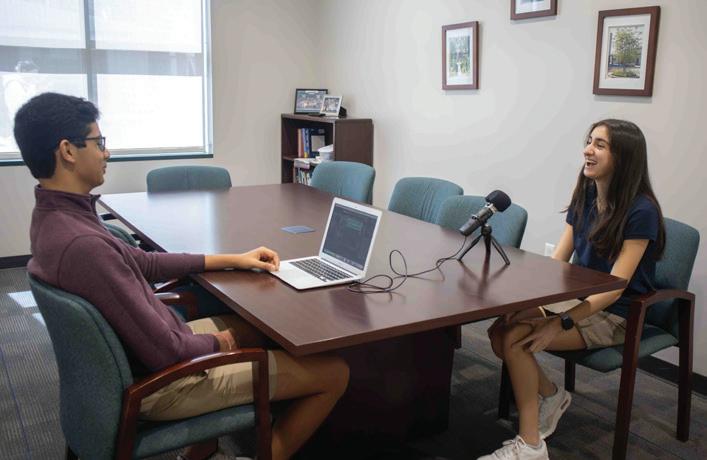
Ep. 7 - Behind the Swoosh



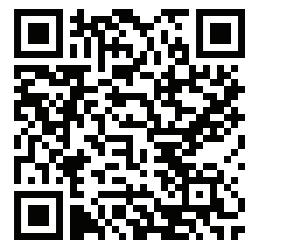
Tune in to Gustavo Membreno as he talks with Mary Remuzzi, Nike Vice President of APLA Communications, as she shares her journey in the corporate world and the story behind the swoosh. Learn more about life at one of the largest brands in the world.

3 March 2O24 Sta /Podcast
Blurbs by Mohil Kapadia & Gustavo Membreno Photo by Olivia Prince & Graphic by Caden Liu


NEWS BITES
This Month: By The Numbers

The cost of Apple’s new augmented reality Vision Pro headest $3,499



The speed in miles per hour of wind gusts initiated by a 19O

blizzard in Sierra, Nevada

Trinity’s Headlines


“Trinity Prep School of Florida” app launched on the App Store and Google Play



Number of Super Bowl viewers, 123,4OO,OOO

breaking the record for the most-watched TV program in history

Above
The annual Culture Fest and World Language Fair were held on Feb. 22 and 23, respectively


Varsity Boys Lacrosse sees tremendous growth with over 25 registered athletes this season
St. Patrick’s Day Fun Facts








The first St. Patrick’s Day parade in America was held in New York City in 1762















Saint Patrick originally wore blue, but switched to green after associating with the Irish independence movement in the 18th century
















Despite his Irish notoriety, Saint Patrick was born British to Roman parents in Scotland in the 4th century










by Zach Kleiman, Sofia Haddadin and Aarav Gupta
Caden Liu and Maxi de la Fuente
Spread
Graphics by
March 2O24 News 4
statistics provided by Apple, TIME and NFL.com
statistics provided by Rumson and WorldStrides
Above




PLAY-ING WITH PHYSICS
Physics students enhance middle school play with technology
Article by Emily Lopez-Couto
Photo by Olivia Prince
is year’s middle school play, “ e Perils of Lulu,” is an action-packed comedy that will keep viewers on their toes throughout the whole performance. Lulu Barnes, the loveable main character, endures a series of unfortunate events while trying to visit her grandma. It is a spectacle full of excitement, chaos and laughter. In addition to English teacher Melanie Farmer, junior Connor Nanus and junior Nick Saraiva directing the play, Universal Studios producer John Ryan will also be assisting in the play’s production.
“Mr. Ryan is helping our team reach out to other schools and communities to come, so he’s mostly in charge of marketing,” Saraiva said. “He’s also attended some of the production meetings. It’s pretty cool working with a Universal producer.”
Sixth grader Russell Kropp is acting as the narrator Walter Winslow in “ e Perils of Lulu.” Kropp has acted in several plays before, but never as a main character. He feels that he is embracing the change.
“After my audition, Ms. Farmer told me that my energy matched really well with the
character, ” Kropp said. “I’m basically a real-life Walter.”
While preparing for the show, Kropp said he has made friends and had fun with his cast members. Kropp said he’s looking forward to opening night and hopes for a good turnout.
“ eater isn’t just about the acting,” Kropp said. “It’s about putting on a great performance for people to enjoy.”
Saraiva explains what makes Trinity’s showing of “ e Perils of Lulu” unique.
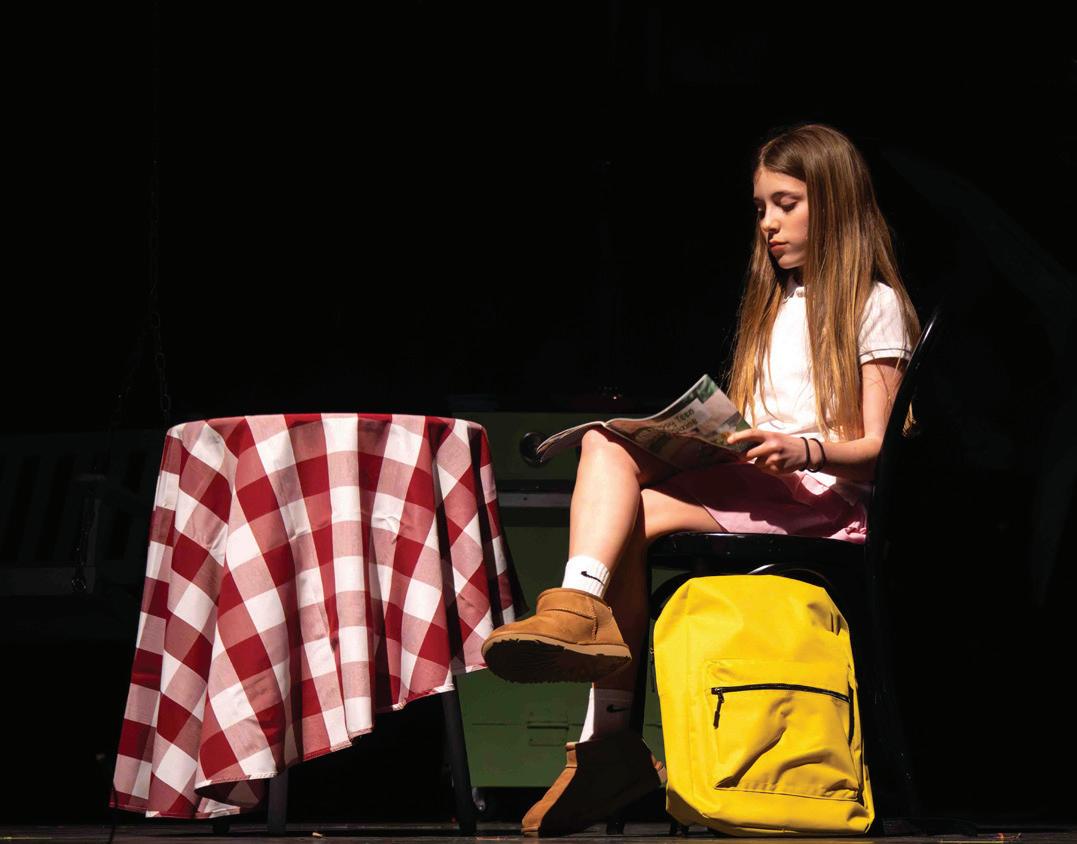
“We really want to bring the essence of this play to life in a way that all the moving parts can now really be seen instead of just described by the narrator,” Saraiva said. “ is is great because the audience is able to consume it better instead of leaving it all to their imaginations.”
Instead of blacking out the stage during

scene transitions, the directors have decided to incorporate them into the play. e idea is to add to the chaos and excitement by showing what would traditionally happen behind the scenes, like set and prop changes. In order to execute this idea properly, both robotics and physics classes will be assisting in set design and working out the mechanical elements of the play.
AP Physics student and senior Benjamin Pringle is currently designing a Newton’s cradle prop, a machine that will be displayed during the show.
“My class is split into groups, and we’re each working to design a machine,” Pringle said. “Some of the students are working on creating a system of pulleys with backpacks that will deliver props and clothes to the actors throughout the show.”
Kropp believes that this will enhance the theatrical experience for viewers.
“It’s such a chaotic show and there’s a lot of stuff ging on, so with all the things [the physics and robotics students] are helping with, it just makes the play even better,” Kropp said.
March 2O24 News 5
Seventh graders Lilia Ashcraft and Gabriel Rupp rehearsing for “ e Perils of Lulu,” which ran Feb. 28 - March 2.
Sixth grader Viola Mandia rehearses her lines on stage.




SO LONG SOCIAL MEDIA
Article by Sofia Haddadin Graphic by Lia Garibay
Picture finally getting home from a long and strenuous day at school, having taken multiple tests and just craving a moment to relax. However, when you open up Instagram, you are left in a state of confusion and frustration as a message on your screen tells you that you have been permanently banned from the app until you turn 13 years old. is hypothetical scenario may become a new reality with HB3, or Online Access to Materials Harmful to Minors, which aims to highly restrict minors’ social media usage across the state of Florida.
HB-3 originally stemmed from HB-1, a highly restrictive social media ban bill which originally banned teenagers 15 and under from creating accounts on popular social media sites and requires social media companies to delete existing accounts held by those under the age of 16. Companies that are caught violating this law could face hefty fines of up to $50,000 per violation. Supporters of the bill claim that it will protect the mental health and safety of kids and teens online in Florida. After Governor Ron Desantis vetoed the bill, Florida lawmakers revised the bill in the hopes of compromising. e revision includes banning children under 14 years old, allowing it for children 14- and 15-years old with parental consent, and allowing those 16 and above to access social media freely. e Senate overwhelmingly passed the revamped bill on a bipartisan vote of 30-5.
use independent organizations to enforce such a policy. e program will also verify the ages of existing accounts and deny accounts of those who refuse to verify their age, making it difficult for kids and teens to bypass the bill’s tight restrictions.
e revamped bill mentions issues related to addictive features and algorithms. Digital communication is an extremely important aspect of daily life, especially for teenagers. In today’s world, technology and social media are the main avenues teenagers use to connect with one another and build long-lasting relationships. Some might use it to keep in contact with friends from other schools or family
bly doesn’t get to decide what parents do with their kids or what they do with their lives.”
Gaines mentions how the ban will have implications for Trinity’s advertising campaign. Although Trinity mainly focuses its marketing efforts on parents and families, prospective students also factor into the marketing mix. Current Trinity students also use social media platforms to learn about the latest updates posted by the school’s social media sites. is makes social media important when it comes to staying connected.
“We are in this wonderful age of expression where being on social media provides us this platform to stay in touch with our friends, to stay in touch with family who don’t live in the same state as us, or maybe even friends who live in a di erent country.”
- Kelly Gaines, Director of Marketing and Communications
that live far away. With the passage of HB-3, participating in such communication will be more of a challenge for teenagers across the state of Florida.
“We’ve also witnessed where [students have] been watching us on YouTube and checking us out on Instagram,” Gaines said. “... It’s been a great resource for the kids to really see our brand, to see an authentic footprint of what is in the life of a Saint on a daily basis, be it a community service initiative or a student leadership program that’s being managed on campus, Culture Fest, Author Fest or the senior retreat.” Without this type of outreach to students on social media, Trinity’s marketing department will have to think outside of the box and find alternative methods of communication to reach out. is would mainly affect current Trinity Prep students.
However, kids and teens will still attempt to bypass the age verification. Sophomore Samantha Nappi said that many teens will try to set up a fake account and enter an older age to be able to access the apps.
While many may will attempt to bypass the age verification, the task proves to be more of a challenge than most may think with the use of “reasonable age verification,” a secure method that will be used to check the ages of those creating social media accounts. According to CBS News, the platforms will be required to
“We are in this wonderful age of expression where being on social media provides us this platform to stay in touch with our friends and family who don’t live in the same state as us, or maybe even friends who live in a different country,” Director of Marketing and Communications Kelly Gaines said.
However, Nappi’s stance on a social media ban bill acknowledges the positives as well as the negatives.
“I agree but also disagree [with HB-3] because people will argue First Amendment rights and freedom of speech,” Nappi said. “But I also disagree because the state proba-
“We all would have to go back to the more archaic channels of communication as far as text, e-mail and using the MyTPS portal,” Gaines said.
Reaching students will also be through the avenue of the new Trinity Prep School of Florida App, which is bound to become more popularized if the ban were to be implemented. Since key Trinity Prep social media sites will not be accessible to a majority of the student body, the app will serve as a new way of student communication.
With the ban on social media for teenagers in Florida, community building, communication and outreach will be more of a challenge. However, both Chief Technology Officer Alex Podchaski and Gaines mention that there
March 2O24 6 News




Florida lawmakers discuss bill to ban social media for teens

could possibly be a benefit to the ban for teenagers, specifically regarding their futures.





“When creating an online account, whatever channel you choose, you’re creating your own logo and your own brand,” Gaines said. “You have to consider it like an online resume, and your behaviors, your opinions, your platform is how you’re growing.”




Online social media accounts are a mirror of oneself, and Gaines furthers that one’s actions online can have major implications for one’s future.



“All the content that you put on your account is your brand, and to just be mindful about that and know that future employers could be using that as part of their decision-making process,” Gaines said.


Such a ban could protect kids in the long run, making sure that the decisions they make online when they are young do not come back to haunt them in the future. is is especially significant when applying to college as a senior or for a job later in life. Making sure your personal brand is what you want to represent you in the future is key, and, as teenagers, that might not be the first item on their minds.

e Online Access to Materials Harmful to Minors bill is also detrimental to marketing professions with a primarily kids and teensbased audience.
“You start thinking about things like esports and the gaming industry, which is targeted toward teens,” Podchaski said. “You’re talking about a significant change across the board in just influencers alone. Anybody who was trying to be an influencer or is an influencer whose target market is younger than them just lost an entire market.”












However, regarding on-campus restrictions, Podchaski notes that the technology department is now left with two options since the bill was passed in Florida. e first option would be banning all social media platforms for all students. e second option would be only allowing students who are legally allowed access the social media platforms to utilize them for school purposes only. still allow student-run social media accounts such as the Trinity Prep Student Council account and the Trinity Voice account.


Florida’s HB-3 will have immense effects on brands that mainly aim their marketing campaigns toward a young target audience, community building among kids and teenagers and more. Teenagers in today’s world utilize social media on a daily basis to build relationships and make long-lasting connections. ese key aspects of social media will be threatened with the passage of HB3. However, the ban could prevent young teenagers from doing something on these social media platforms that they could possibly regret in the future, and in doing so, protect their personal brand that will continue to follow them.
Further, Trinity’s technology and marketing departments will have to find ways to adapt to such a drastic change, and students will have to find alternate methods to reach out and communicate with one another both on and off campus.
March 2O24 News 7

PRO: TRUMP BALLOT CASE
Article by Aarav Gupta
Graphic by Maxi de la Fuente

Taking Trump o the ballot will silence millions of Americans and ensure their voices will never be heard. Our politicians do not have the right to choose who we can vote for as it will unleash chaos in our American political system and will put an end to democracy as we know it once and for all.
Trump’s trial centers around Section 3 of the 14th Amendment, otherwise known as the Disquali cation Clause, which prevents anyone from running for o ce who has engaged in an insurrection or rebellion.
It was mainly designed to keep former Confederates from holding o ce after the CivilWar, making sure states treated all Americans fairly and justly regardless of gender or race. Because of this, Trump has not been convicted of engaging in an insurrection, he does not meet the disqualifying requirements laid out in the 14th Amendment.
“ e whole point of the 14th Amendment was to restrict state power,” Chief Justice John Roberts said in the US Supreme Court. “So wouldn’t that be the last place that you’d look for authorization for the states … at seems to be a position that is at war with the whole thrust of the 14th Amendment.”
Furthermore, states using this amendment to justify oppressive ruling is the exact opposite of what the bill’s purpose was intended for.
“No one’s invoked [the 14th amendment] in 140 years, so it de nitely feels like a legal Hail Mary from opponents of Trump to reach for it suddenly,” social science teacher Quinn McKenzie said.
While many speculate that he partook in an insurrection on January 6, it is notable to understand that he has still not been convicted of these crimes. In our country, one is innocent until proven guilty and only then will they face the consequences which ensures that no one is wrongfully accused of a crime, guaranteeing a fair and impartial trial.
“He has not been found guilty of inciting an insurrection and until he does, there’s no proper justi cation for him being thrown o the ballot,” freshman Ashwin Anand said.
Furthermore, as seen in the primaries, Trump has already received signi cantly more votes than the other Republican candidates, highlighting that a signi cant portion of Americans want him as president.
“I think [keeping Trump on the ballot] encourages democracy because he is the preferred candidate,” McKenzie said. “In a true democracy, we would say throw your hands up if that’s what the people want. Allowing what the people want to take precedence over what the legal precedent is probably more democratic.”
According to YouGov, a British international market research company, 65% of Americans believe that the country is more divided than ever. is is cause for concern, as American politics are so polarizing right now that states feel emboldened to remove opposing candidates o the ballot when they disagree with their viewpoints. We must hold the line in Trump’s scenario to ensure democracy.
“It protects against the unfair discrimination of certain political gures because if he is
thrown o the ballot that could open a can of worms,” Anand said. “More and more candidates could be kicked o the ballot for less and less signi cant reasons.”
According to a nationwide poll done by over 1,200 participants from Reuters, Trump leads Biden 40% to 34%. Because of this, voters would like to have their voices heard and their votes represented.
“Trump handily won the Republican primary, so the majority of Republican-aligned voters seemed to want Trump, and they could say their opinions are not being heard or not being respected,” McKenzie said. “To echo our school’s motto, diversity of thought is important.”
In the end, regardless of what party you support, Americans need to do their research before forming opinions on such cases.
“Americans broadly occupy these very small digital media spheres where they’re getting media from their sources that they choose and even if we don’t intentionally do that, the algorithms are going to feed us content that we engage with,” McKenzie said. “We’re going to end up in these hyper polarized media echo chambers, meaning that we’re only ever going to see one side of an issue.”

Removing Trump from the ballot will have devastating consequences for the American people and will unleash chaos in our political system currently.
“I think ultimately whether or not you believe that Donald J Trump inciting an insurrection on January 6th, 2021, has no bearing on this case,” Anand said. “He has not been proven guilty and until he is, there is no cause to remove him from the ballot.”
March 2O24 Opinions

CON: TRUMP BALLOT CASE
Article by Nikhil Daniel
Graphic by Maxi de la Fuente
Donald Trump is an enemy of democracy and should be treated as such. Trump now sits with a total of 91 felony counts from four separate court cases and owes over $500 million in legal fees and nes. Most importantly, his role in the January 6th insurrection against the United States Federal Government serves as su cient grounds to expel the former President from the ballot per the Constitution.
Donald Trump has been temporarily taken o the ballot in both Colorado and Maine for violating Section 3 of the 14th Amendment, the Disquali cation Clause, by participating in “insurrection or rebellion” and having “given aid or comfort to the enemies thereof.” By looking at the text of the Constitution, past precedent and historical background pertaining to the Disquali cation Clause, legal scholars from both sides of the aisle have made compelling arguments for removing Trump from the ballot.

e best way to decide the future is to look to the past. Historically, Section 3 of the 14th Amendment has been used eight times from 1869 to 2022 to disqualify candidates. e most recent was Couy Gri n, a Republican County Commissioner in New Mexico, for joining and inciting the January 6th mob attack. Gri n was not accused of personally being violent or entering the Capitol building but was still expelled for aiding and abetting the insurrection. is same precedent should apply to Trump. e best way to make decisions for the future is to look to the past.
Trump’s lawyers argue that Trump should be innocent until proven guilty, as he has not been convicted of the four felony counts for attempting to overturn the 2020 election.
Historical precedent shows that a criminal conviction is not required for an individual to be disquali ed under Section 3 of the 14th Amendment. Out of the eight individuals the clause has been applied to, ve were never convicted of a crime.
Two of the most prominent conservative constitutional scholars in America, Professors William Baude & Michael Stokes Paulsen explain that when a candidate fails the rule of disquali cation under Section 3, an o ceholder is disquali ed. Automatically.
In addition, the idea that Trump did not incite or aid the insurrection is inaccurate at best and dangerous at worst.
“It would be hard to describe the physical breaching of our capital and the harming and killing of guards of that capital with the explicit intent of undermining a democratic process like an election as anything other than an insurrection,” social science teacher Quinn McKenzie said. “I think it would be hard to say the man, [Donald Trump], that told those people to go there and ‘ ght like hell’ was doing anything other than encouraging them to do those things.”
As Trump’s election interference trial gets pushed back time and time again, the verdict will not come before the election, so it falls upon the states to stop the former president from being on the ballot.
Trump’s lawyers also argued that the president is not an o cer of the United States as it was not explicitly stated in the Constitution, therefore he is exempt from the Disqualication Clause. In the United States, there is no sovereign ruler, but instead, o cers of the country, who are meant to serve and protect American interests. It seems farfetched to assume that the framers isolated almost every available position in public o ce but meaningfully left out the President. It is instead more likely that it was an implicit certainty that the most senior o cer of the United States, the President, would be held liable if they “engaged in insurrection or rebellion.”
e idea that Trump is above the law makes the presidency equivalent to a monarch.
“I don’t think that the President should have all-encompassing immunity for every-
thing that they do while they’re in o ce,” senior Ayush Patel said. “It doesn’t set a good precedent for the future. en they could, as president, murder someone and then after they leave o ce think, ‘I have immunity; it doesn’t matter.’”
Trump willfully engaged in inciting an insurrection and now must pay the piper.
ough the initial intent of the framers was to prevent members of the Confederacy from gaining public o ce, attempting to subvert democratic norms to bene t personal interest is antithetical to the President envisioned by the Founding Fathers.
“Section 3’s disquali cation clause has by no means outlived its contemplated necessity, nor will it ever, as the post–Civil War Framers presciently foresaw,” wrote former federal judge J. Michael Luttig and the Carl M. Loeb University Professor of Constitutional Law Emeritus at Harvard University Laurence H. Tribe. “To the contrary, this provision of our Constitution continues to protect the republic from those bent on its dissolution.”
e Constitution serves as the supreme law of the land and serves as a prerequisite to voting in the rst place. Questions of political backlash and consequence should be secondary to upholding our founding document as the United States does not exist without a Constitution that is upheld on its merits.
e argument that disqualifying Trump could be a slippery slope to expel other candidates from the ballot is illogical as no other candidates have engaged or aided in insurrection or rebellion.
“I think to hold an insurrection against the government, you have to feel very strongly that something about the government is broken beyond repair,” McKenzie said. “If you feel that something beyond the government is broken beyond repair, I see no legitimate reason you would want to be a part of that government short of wanting to dismantle it.”
Donald Trump is a past, present and future threat to democracy. e judiciary must act swiftly and vigorously, to ensure a future in which those who wish to destroy our nation, can never be a leader of it.
March 2O24 Opinions




PARENTAL ADVISORY NOT NEEDED
Article by Peyton Alch
Graphic by Caden Liu
It is a situation we all know and fear: grades are released to that test you know you did not do so well on. Moments after the Canvas noti cation pops up on your phone, you receive that dreaded noti cation from your parent: what happened with your grade?
In a study published in 2015 by the Journal of Personality and Social Psychology, researchers found that high parental expectations led to increased academic achievement in children, but when parental aspirations became unrealistic, the child’s achievements decreased.
“Although parental aspiration can help improve children’s academic performance, excessive parental aspiration can be poisonous,” lead author Kou Murayama said. ere is a di erence between wanting your child to succeed and forcing them to. It is important to be conscious of overparenting, which is the idea that parents have a large amount of control and involvement in their child’s life. It is this overparenting that causes children to feel increased amounts of pressure. is pressure leads to increased anxiety levels, which can decrease academic performance.
the teacher to ask for a better grade with no genuine reason. is communicates to the student that their parents care less about their progress and more about their nal grades. It is important for parents to take into consideration the time and e ort that academic improvement requires.
“I think people don’t understand that there’s a way that things get worked through, it’s not a switch you just ip and now it’s all xed,” Omawale said. “ ere’s work involved.”
Another issue that has become all too nor-
“Sometimes it’s hard to let your kid fail, sometimes you want to do whatever you can do to help them, but that’s not always the best way.”
- Bridget Hawley, Trinity parent and Board of Trustees Member
A 2002 study conducted by the University of Michigan found that 80% of college students equate their self-worth to academic validation, creating an unhealthy relationship with education and an increased fear of failure.
“ at’s one downside for when there’s too much pressure on the grade,” Spanish teacher Malika Omawale said. “ ere’s less focus on the actual learning.”
When a parent is constantly checking Canvas, or nitpicking every 10-point assignment, it becomes a problem because it prevents students from taking ownership of their work.
“Sometimes it’s hard to let your kid fail, sometimes you want to do whatever you can do to help them,” Trinity parent and Board of Trustees member Bridget Hawley said. “But that’s not always the best way.”
One problematic behavior is the heavy focus on grades, sometimes referred to as “grade grubbing,” instead of a child’s progress. Grade grubbing is when a student or parent goes to
malized is when parents decide to contact teachers before encouraging their children to take action. Canvas makes it easy for parents to regularly check grades and monitor their student’s progress, and this accessibility gives parents more leeway to reach out to teachers.

ere are certain points when a parent should get involved, but a parent should not be in constant communication with a teacher about their child’s progress; it is not only frustrating for the student, but their teacher as well. If parents are constantly speaking for their children, it sends the message to the students that they are not capable of doing it on their own.
“[Students] need to learn to advocate for themselves and be responsible for themselves,” Omawale said. “ e ultimate goal is for them to be independent learners. We’re a team, and part of that team is the parent, teacher and child.”
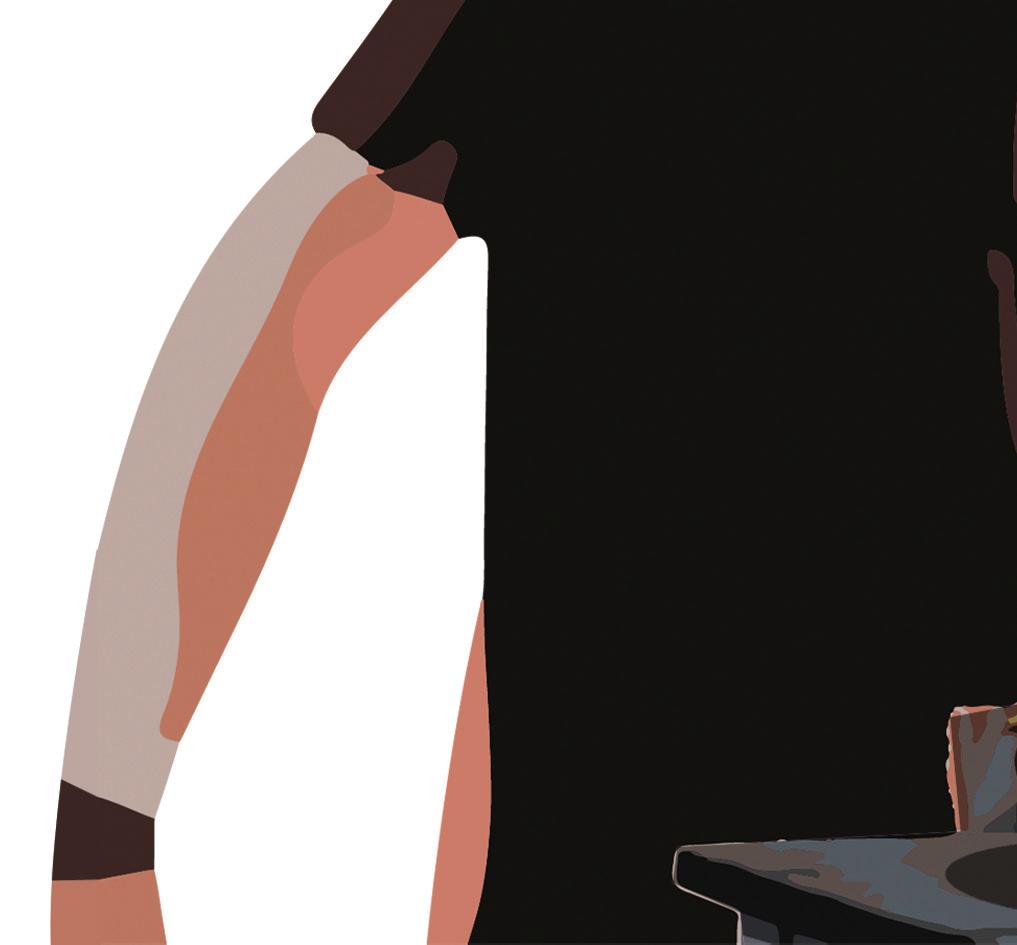
March 2O24 1O Opinions




Parents blur the line between involvement and control in education

is hand-holding hinders students’ ability to function e ectively in college. Learning proper study skills and independence is a huge bene t of a prep school education, and letting students learn to navigate this is important. If they are not able to develop these habits, it can hurt their ability to thrive in college and beyond.
“You have to look at your kid and ask where do they need my support and help, and where would it be good for them to struggle a little on their own?” Hawley said.
Parents have also had an increased involvement in their child’s course selection, choosing only the best and most rigorous classes for their children.
If a student does not want to take APs or honors classes, they shouldn’t have to.
Parents have to be ready to accept the limitations the child sets for themselves and encourage them to try their best in classes that t them. It is a question of what the student can thrive in, not how many APs they take.
If parents try to control what classes their children take, they are not letting their children’s education be their own.
Despite these issues, parent involvement is not necessarily a bad thing when practiced in moderation.
Freshman Presley Sherman considers her parents to be more involved than most, but Sherman feels like her mother’s involvement motivates her to work harder.
legislation like the “Don’t Say Gay Bill,” restrictions on the AP Psychology curriculum, and the banning of over 700 books in Orange County alone. Parental involvement in education is increasing.
ese attempts to change the curriculum have negative implications for students.
Prohibiting what they learn and what resources are available to them only hurts them, and stops the ow of ideas and growth.
“[Students] need to learn to advocate for themselves and be responsible for themselves. The ultimate goal is for them to be independent learners. We’re a team, and part of that team is the parent, teacher and child.”

- Malika Omawale, Spanish teacher
“I feel like for some kids if their parents aren’t as involved they don’t try as hard,” Sherman said. “I feel like since she pushes me I’m like, ‘Okay, I’ll try to do better.’”

A parent’s active interest in students’ education can help them thrive and give them motivation to work harder. e issue arises when parents cross the line of what is appropriate for involvement, and directly insert themselves into their child’s education.
is involvement is not only found in parent-child relationships, but has expanded from personal involvement to a push for state laws, as parents try to use legislation to alter the curriulum in schools.
is is especially prevalent in Florida, with
Parents should refrain from controlling all aspects of their child’s education. ey must nd the balance between control and encouragement.
Finding that balance requires open communication between the parent and child.
Both parties need to understand expectations and boundaries. is requires trust. Parents need to trust that their children are capable of doing things on their own and trust the school to provide them with the skills to do that. Part of this requires that parents let go and accept that it is up to their children to decide who they want to be.
“If you can nd your sweet spot in the middle and nd the balance, that’s where you’re the most successful,” Hawley said.
When parents incorporate these practices into their lives, it helps their children’s independence and self-regulation and helps them grow into strong, ambitious adults.
“We’re teaching our students to be leaders,” Hawley said.
e ultimate goal is to help your students succeed. Parents need to understand that there is a ne line between being involved in their child’s education and controlling it.
“I think that’s where you can cross the line sometimes,” Hawley said. “ ere is a balance, you need to nd [it] because not every kid is the same.”
March 2O24 Opinions 11




CONSUMER ACTIVISM:
Article by Sebastian Cabeza Graphic by Sam Miller
Many of the commodities we enjoy today, from smartphones to the clothes we wear, are the product of some form of worker exploitation, environmental degradation or both. For example, according to UNICEF, over 60 million children are made to work in sweatshops to make the clothes we buy at most major retailers. However, most people are either unaware or indi erent to this fact because, as consumers, we only engage with the nished product.
When you go to a store or shop online, all you ever see is the product and a price tag, as if the product just appeared out of thin air. e average consumer is so far removed from the process of production that it becomes an abstract concept that has little to no e ect on their willingness to purchase. is alienation between producer and consumer is a phenomenon often referred to as commodity fetishism, which Karl Marx rst described. He argued that instead of a commodity being the product of human labor, it becomes simply an item on a shelf with a price tag, taking away the social character of the commodity by “fetishizing” it with an objecti ed value.
“ e fetish is, in that sense, treating everything like a commodity, and that’s just something that we all do in practice,” said assistant professor at the University of North
giving over money, and we’re saying, ‘I’m giving you $5 for this bag of chips, candy and a drink, and you could calculate any other thing you could buy in the world in terms of that $5. ey’re all commodities; they’re all equal. It doesn’t matter [how] they’re made.”
By alienating the consumer from the producer, the exchange of commodities is transformed from an exchange between humans to an exchange between objects. rough this phenomenon, it then becomes possible for people who would otherwise be disgusted by the violence and coercion that goes into making the products they enjoy to inadvertently participate in it.
THE CONGO
e harmful impact of commodity fetishism is most evident when analyzing the current situation in the Democratic Republic of the Congo. Almost every piece of technology bought and sold on the market today has a rechargeable lithium-ion battery made from cobalt, from smartphones to electric vehicles. A lesser-known fact, however, is that 70% of the cobalt used to make these batteries comes from the Congo, where hundreds of thousands of Congolese miners are forced to work under brutal conditions, which many have labeled as modern-day slavery.
e Democratic Republic of the Congo’s
cobalt mining industry is dominated by multinational corporations, which employ some 255,000 workers, 40,000 of whom are children, according to the Woodrow Wilson International Center for Scholars. ese miners are paid less than the equivalent of $2 per day and are made to toil long hours in the sun with very little food or water, operating with only basic tools or simply their hands. According to a 2022 study published by e International Journal of Life Cycle Assessment, the subhuman conditions of the mines cause approximately 2,000 fatalities per year.
ese mines take up vast tracts of land, some already inhabited. To make way for the mines, multinational companies have conspired with the military and other armed groups who have control over resources to forcefully evict tens of thousands of residents, committing several human rights abuses along the way. Amnesty International reported in 2023 that soldiers often brutalize, sexually assault and/or kill villagers before burning their settlements to the ground, leaving them with nowhere to go. According to social science teacher Brandon Burmeister, these abuses often receive very little attention from the media, if at all.
“You got 7 million internally displaced people,” Burmeister said. “You have failed state status. You have the type of war crimes we see in Afghanistan or in Ukraine happening daily. But it’s one of those things where people don’t pay attention because they’re like ‘Oh well it’s

March 2O24 12 Opinions




COMMODIFIED SOCIAL JUSTICE
just Africa.’”
e crimes of the mining companies do not stop there, as they also often bulldoze entire elds of crops to make room for more excavation. is is made even worse when considering the fact that, according to the United Nations, one in three people in the Congo face severe or acute food insecurity.
e cobalt excavated through this cruel exploitation of Congolese workers is then used to make products marketed as green alternatives, such as electric cars. However, the mining process itself is extraordinarily environmentally destructive. Cobalt mining creates large amounts of toxic waste, which destroys entire ecosystems, contaminates crops and pollutes sources of water. Dust and grit kicked up by the excavation also pollute the air around the mines, making it toxic to breathe and causing severe birth defects in the communities surrounding them. To top it all o , mining operations destroy large swaths of the Congo Rainforest, a vital ecosystem that absorbs nearly 1.5 billion tons of carbon dioxide per year, according to the United Nations Environment Programme.
e Congolese miners whose homes are destroyed and who are forced to risk their lives and health every day in the mines see none of the bene ts of their grueling labor. All of the wealth created by their su ering is pocketed by the mining companies and their shareholders, continuing the process of colonial extraction that has kept the country
chronically underdeveloped for over a century. Meanwhile, big tech companies like Apple and Tesla reap all the rewards while doing nothing to x the barbaric oppression that a ords them so much economic success.
All of this, however, is completely hidden from the consumer. When you walk into the Apple store to buy the latest iPhone or MacBook, you do not see the innocent men, women and children forced to work themselves to death for the pro ts of multinational corporations; all you see is a sleek, modern store lled with tables lined with shiny, overpriced tech products.
SO WHAT?
Because of the separation between producer and consumer, many people have bought into the idea of “voting with your dollar” or ethical consumption. People want to buy ethically sourced products, arguing that their consumer choices alone can push rms in the right direction ethically and environmentally. is “consumer activism” purports that the world’s problems can be solved by simply buying the correct products, whether that be an electric car or a reusable water bottle. Companies are conscious of this increase in consumer awareness and have used it to their advantage
by marketing their products as green or ethically produced, even when they are not. In e ect, our capitalist system has co-opted and commodi ed activism against itself.
e truth is that there is no such thing as ethical consumption under capitalism. Voting with your dollar is a futile e ort that companies actively play into to swindle more people out of money by charging more for “ethical” products. Corporations have duped the public into believing that they can change our system by just buying the right thing, creating a whole society of well-behaved consumers who would rather engage with objects than real people or institutions. While this is frustrating, and there is no easy x, the ability to recognize the problem is a crucial rst step towards nding a solution. If that were not the case, then corporations would not spend as much as they do on marketing to hide the glaring issues with their practices.
“[If] the only way we try to improve things in the world is getting people to change their consumer practices, it’s not going to work,” Skotnicki said. “[People] say, ‘Oh, if you just change your buying practices, we can x everything in the world.’ No, absolutely not.”

Opinions 13 March 2O24


WHO IS THE TRUE USER?
Social media’s hold on Gen Z is stronger than you think.
Article by Taylor Riley
Graphic by Lia Garibay
“What does it mean that, having been part of the internet for so long, the internet is also a part of me?” John Green writes in “ e Anthropocene Reviewed.”
Today’s quad looks vastly different than it did 20 years ago. Students walk with their faces buried in their phones, work on MacBooks rather than notebooks and film TikToks in the school bathrooms. e prevalence of social media and the internet is relatively new, so teenagers should be wary of the possible unintended consequences of living their lives on the internet. ese apps are using us just as much as we are using them, affecting us in ways we often don’t realize.
To observe this effect, look no further than “Sephora preteens,” the recent phenomenon of young girls ages 10-13 taking over makeup stores such as Sephora due to being influenced by older content creators on social media. Senior Claire Pankros believes this push to look and act older robs preteens of important childhood experiences.
“ ere’s this need to grow up faster in order to fit with what’s trending,” Pankros said. “You don’t really realize what you’re missing out on until you’re older.”
Social media’s influence over what we purchase, listen to and how we act goes beyond limiting the carefree nature of childhood. It also creates a lack of individualism in its users, especially in impressionable teenagers who are still figuring out their identity. Psychology teacher Michael Brown agrees that seeking online attention can cause people to lose sight of themselves.
“If I’m getting that dopamine hit every time somebody likes something of mine, naturally, I’m going to want to do it more,” psychology teacher Michael Brown said. “...[Social media] has us chasing this facade of a human rather than an actual human. It feels like everyone’s forced into wearing a mask.”
Social media platforms push users to fit with what’s trending, which can sometimes cause us to be more cautious, choosing hobbies
based on whether or not they’ll look aesthetic on Instagram. We’re not just curating our feeds, we’re curating our personalities.
In the podcast, “ e Random Show” by Tim Ferriss, he brings up the concept of “personality by consensus,” the idea that social media acts as a feedback loop, with users sharing content and altering themselves depending on how many likes and comments it gets.



“Just look at personalities online over time who spend a lot of time on social media… they have certain behaviors rewarded, certain behaviors punished, certain behaviors left unapplauded,” Ferriss said in episode #493 of his podcast. “ ey start to warp and bend their behavior to fit the most applause…And I think that that ends up inevitably bleeding over into their real lives.”
Social media’s influence doesn’t just alter how we present ourselves to the world, it also shapes our internal world view. A study published in the scientific journal, Psychology of Popular Media, “Empathy, Narcissism, Alexithymia, and Social Media Use,” showed increased social media use correlated with lowered empathy and higher narcissism and alexithymia, which is classified as difficulty feeling and identifying emotions. Brown agrees that the internet tends to amplify whatever internal struggles a person is prone to.
“[Social media] feels like it’s a stimulus,” Brown said. “It takes whatever you might have issues with and just gas pedals, and hits you all the harder.”
Along with fueling personality disorders, the internet also strips teenagers of the right to forget their mistakes. You’re probably not the same person you were when you were 13, but when that version of you is immortalized on
the internet, it’s harder to escape. e digital footprint is easily traceable; Generation Z is essentially walking through wet concrete with every like, comment and post.
“ e Internet…tends to scale up mistakes to monumental proportions, and to put them on our permanent records,” writes New Yorker writer Nausicaa Renner. “Colleges and employers now look at social media accounts for evidence of character… What is it like to live under threat? What are the ramifications when an entire generation never gets the chance to experiment freely or to remake themselves?”
A 2023 survey by Gallup reveals that teenagers spend an average of 4.8 hours per day on social media and a 2023 study conducted by Cross River erapy found that around 70% of teenagers and young adults in the U.S. are addicted to social media. We are the first generation to grow up with social media at our fingertips, and as these statistics display, we haven’t yet figured out how to handle its power without letting it consume us.
Social media influences our choices and shapes our identities, which leaves us with the terrifying question: what is left of us as individuals? We must figure out how to navigate the modern world of social media while retaining our sense of self.
March 2O24 Opinions 14
Opinions
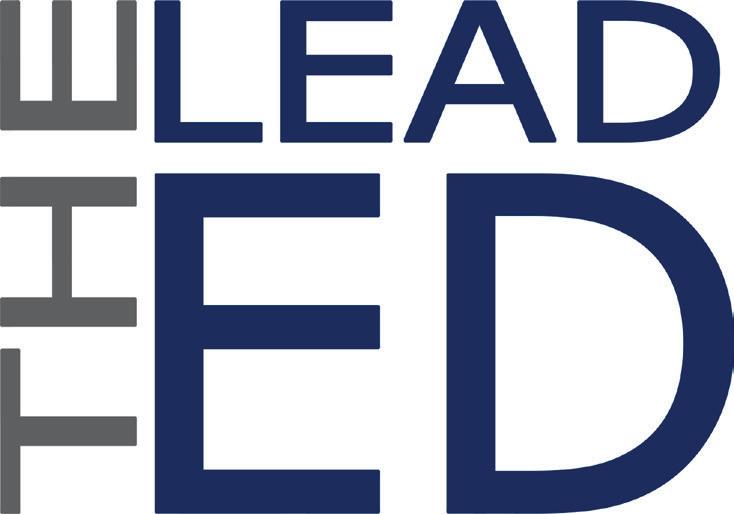
is past school year, we have had two early release days – October’s Lunch on the Lawn and February’s professional development day.
e fact that this has occurred twice now proves that this is a feasible reform. is shortened schedule should not be saved for unique days, but rather should occur every Friday.
e plan for a reformed schedule would remove the flex break and middle block on the second C-day of the week, leading to a 1 p.m. release time. is is a concept that Trinity has never fully integrated into our schedule, but poses a series of crucial benefits. On a typical school day, many students have practices until 7 p.m., but an early release day could help provide more time in the afternoon to complete all of their assignments that they normally have to stay up excruciatingly late to complete.
Scheduling committee member and guidance counselor Rylan Smith said she has seen numerous students come to school sleep-deprived after being overwhelmed with homework, resulting in poor mental health the following day. If the school changed the second C-day of the week to end earlier, students would have more time to finish their homework and get to sleep earlier. is in turn will not only lead to a higher chance of productivity, but an increase in sleep that can improve the mental health of all students.
“I think we waste a lot of time [with the current C-day schedule],” Smith said. “So from a mental health standpoint, I definitely think there could be some benefits to pushing through the day. But you have to find the balance between breaks [that] are also beneficial to mental health.”
is is not just a change that can improve mental health, but the academic success of students as well. According to the education policy journal, Education Next, a one-hour difference in a schedule with an early release or late start has been proven to increase math scores by 8 percent.


TIME FOR A CHANGE
Aside from students, the early release schedule will also benefit the backbone of our education: teachers.
“I would appreciate a shorter day schedule so that we would have time for meetings or planned activities,” scheduling committee member and science teacher Bryan Moretz said. “[It] will also be a good time for us to get caught up with grading… [and] all the other things that teachers don’t have time to do, that we sometimes have to do on our personal time, such as, make parent calls, send emails, you can grade papers, make copies, that kind of stuff that we sometimes just don’t have time to do during the day.”
Back during the early release day in February, the schedule was shortened specifically for a professional development workshop. is change allowed for teachers and administration to attend without removing necessary parts of the schedule to do so.
“Just as students are constantly learning, teachers are as well,” Moretz said. “It would be a benefit primarily because we are using that time wisely after school. Instead of having to expect teachers that have lives outside of school to be here until 4 p.m. or 4:30 p.m. It would make sense to be more mindful of a teacher’s life outside of school.”
With the prospect of reforms, new challenges arise as well. One of the most glaring downsides is less time allotted for the college counseling department.
College counselors run a class for juniors during the second middle block of the week. is reform would leave counselors without a time to accomplish this. Nevertheless, college counseling could move their workshop from this middle block to during a lunch.
Additionally, another problem arises in regards to after school activities such as sports. Many of the current athletic coaches have jobs outside of school and would be unable to leave their jobs to start matches or practices earlier. As a result, a number of student athletes may have to wait at school with nothing to do until their sports commence.
An early release schedule may pose a small inconvenience to some of the sports on campus, but there still is a potential solution for the others. Many athletic coaches are teachers here as well, so they would be able to start their practices early. In doing so, it would allow these after school activities to end roughly two hours earlier than they normally do. is provides valuable time to both the coaches and the athletes that typically arrive home late at night.
ough some flaws can be partially addressed, another hole in this plan is found when examining the pick-up of students. Because many students remain on campus long after school ends due to their parents’ inability to leave work earlier, there would be an even larger issue for parents if class ended even earlier. Public schools utilize busses in order to transport kids daily even if there is an early release. Trinity has no such transportation system, so we can not do the same. Students without extracurriculars or after school activities would be stuck in school with nothing to do. Either way, the trend of unproductivity in our current schedule remains.
ere is no perfect schedule. Both concepts of the C-day schedule – the one implemented and the one proposed – have their downsides. Some parents may find a way to come to school earlier to pick up their kids, and others will not. Regardless, the benefits that this new schedule provides for the majority of faculty, staff and students outweighs the few problems that may arise.
It is time for a change. Our schedule would greatly benefit from a new reform, and this reform should take place as soon as possible. By removing our second C-day of the week of the significantly long break, the academic success and mental health of students and faculty can dramatically improve.
e lead editorial expresses the opinion of the Trinity Voice editorial staff. Please send commentstovoice@trinityprep.org.
March 2O24 15









March 2O24 Advertisements 16 JAIME H. MEMBRENO, M.D., F.A.C.S. 660 S h o r e v i e w Av e . W i n t e r P a r k , F L 3 2 7 8 9 www.rmseye.com M a i n : 4 0 7- 9 3 1 -1 5 1 0 F a x : 4 0 7- 8 3 9-1 8 2 9 1 0 0 Pa r k P l B l v d . , St e 2 0 2 K i s s i m m e e , F L 3 4 7 4 1 F a x: 4 0 7-93 1 - 3 7 5 9
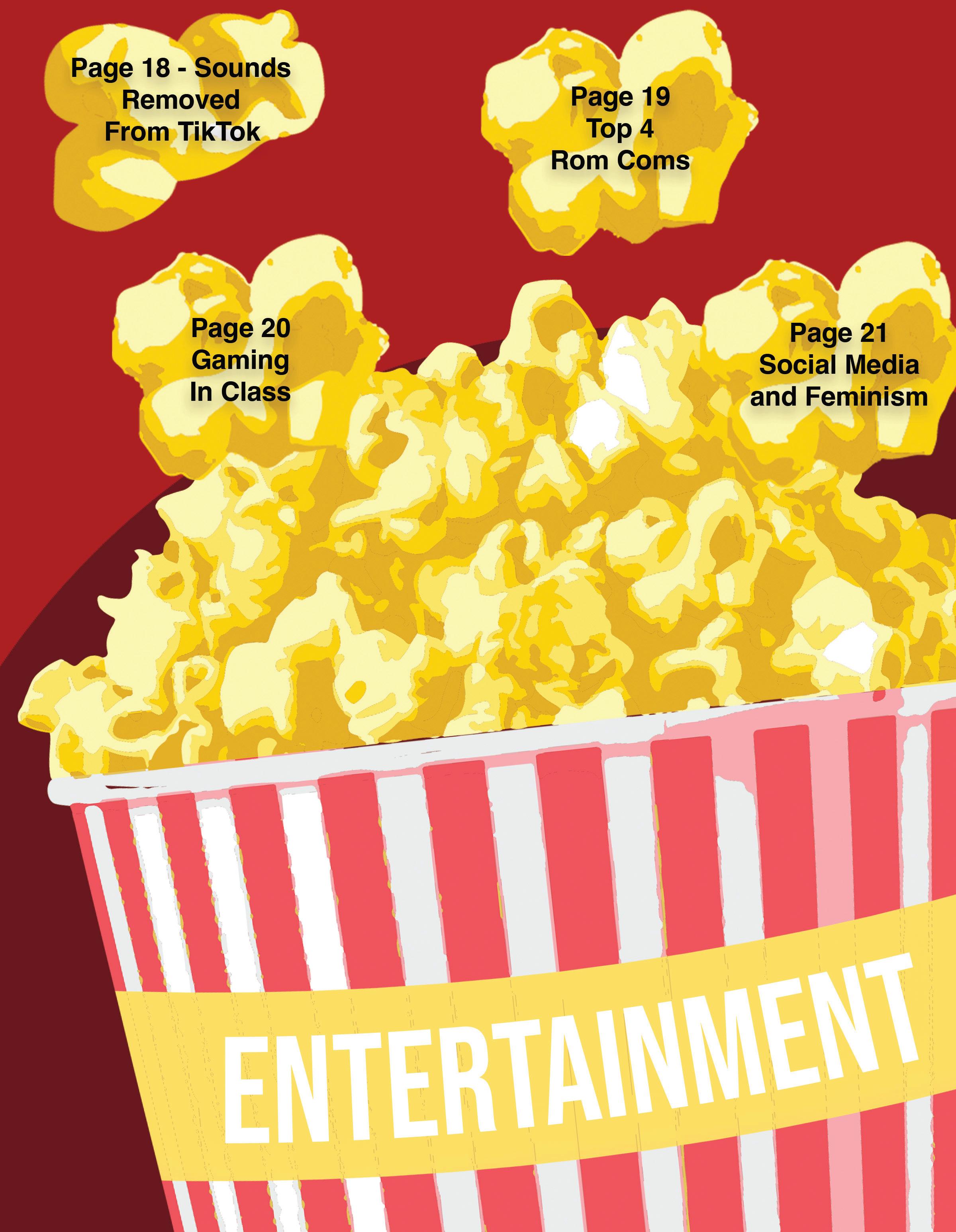




17


TIKTOK SOUND NO LONGER FOUND

 Article by Taylor Gri th
Graphic by Caden Liu
Article by Taylor Gri th
Graphic by Caden Liu
Seventh grader Gabby Aaron excitedly opens her TikTok to search for her favorite Taylor Swift song to record a new video. She clicks on the sound but no music comes out, leaving her with a silent video. She scrolls for other sounds to see that all of Taylor Swift’s songs have been removed, as well as other artists like Drake, SZA and Rihanna. Aaron swipes out of TikTok, no longer wanting to make a video without any music she enjoys.

On Jan. 31 Universal Music Group (UMG) failed to reach a new licensing deal with TikTok, leading to thousands of UMG-owned sounds being abruptly removed from the platform. Many of the popular artists Bad Bunny, Taylor Swift and Olivia Rodrigo were silenced. Not only will users not be able to make new videos with UMG’s sounds but previously posted videos will now be muted. is making this protest against TikTok to negotiate lower prices for music usage and for the artists contributing their music to get fair pay. e consequences leave many users upset that they are unable to access their favorite songs.


small artists have lost their platform for promoting and sharing their music with listeners. “Small artists have a hard time promoting their music without TikTok since that’s where most teens hear music,” Wasyliw said.


again at this rate,” Gray said in an interview in


“Due to the recent changes I’m scrolling through TikTok and I can’t hear the artists that I enjoy listening to everyday anymore, so it’s very disappointing to go on TikTok now,” sophomore Eva Wasyliw said. is is leaving users to tertaining than it used to be. According to In uencer Entertainment, in past years, lipsyncing and dancing on TikTok have been popular, but since the removal of sounds, TikTok engagement rate has dropped by 28% and is dropping steadily. Other users are also concerned about previously posted TikToks that are now soundless.













“I have to delete my TikToks that don’t have sounds now, and it makes me kind of sad that I can’t rewatch any of them because it has no meaning to it anymore,” Wasyliw said. “It’s just a video with no sound. ese videos have meaning to me and now they don’t without sound.”

Many believe that TikTok is struggling with user engagement without the core artists’ music. With all of these recent TikTok changes,
Many artists empathize with Gray since TikTok is a platform which reaches many erent types of audiences. TikTok has not reinstated the contract with UMG because rst agreements with the other labels and publishers. TikTok claims that UMG’s actions are not in the best interest of the artists, songwriters and fans. UMG argues that they are trying to get the artist the pay

the Daily Beast. which di they made artistthat they deserve.
ed to switch to a di

In reaction to the ban, some users deciderent app like Instagram Reels, where users can access all music, lters and texts. According to tech website Hackernoon, Instagram content engagement rate is up 93% since the recent block. Instagram is rapidly increasing, and the app is becoming an
alternative to TikTok.
“I used to use TikTok about every day, but
now I don’t really use it as much

Artist Conan Gray, whose songs are owned by UMG, began his career with the viral song “Heather,” which gained popularity rapidly due to trending on TikTok. TikTok was the reason Gray’s album became so popular.
“I’m never going to have a hit song ever

since the use other social media.” struggling to
sounds have been removed,” Wasyliw said. “I
With all of these recent changes, artists are nd an alternative to promote their music. TikTok has been struggling with nding an agreement with UMG. Until then, users will remain without access to 21 popular music artists. Many users are left wondering what the future for the popular music video platform will be.
March 2O24 Focus 18




Rights and Wrongs of Rom-Coms
Reasons
why these three rom-coms are the best in the
Article by Lucy Chong
Graphic by Lia Garibay
As Valentine’s Day festivities o cially come two a close, it is time to review our favorite romantic comedies. e following list is a comprehensive ranking of the top three rom-coms to watch next Valentine’s Day season. Each of these lms has been graded 1-10 in romance and comedy, totaling a score out of 20.
3. Crazy Rich Asians
“Crazy Rich Asians” chronicles the romantic getaway of Rachel Chu and Nick Young to Nick’s home in Singapore, where Rachel learns the hidden truth about the family of her long-term boyfriend: they are uber-wealthy. roughout their trip, both Rachel and Nick are forced to navigate their relationship as protective mothers and judgemental aunties try their best to drive them apart. e romance in “Crazy Rich Asians” is something quite literally out of a novel, from the lavish setting to the dreamlike wedding Rachel and Nick attend. Stir that in with the major obstacles our leading couple is forced to overcome, and you have the perfect formula for a 10/10 romance. Comedically, however, our No. 3 lm only earns a 7/10. Despite the numerous laugh-outloud scenes, which primarily feature Rachel’s best friend, Peik Lin, the lm also deals with a lot of heavy topics such as Ingrid’s divorce and

Rachel’s struggle to be accepted, which tend to really bring down the mood. Scoring a high 17/20, “Crazy Rich Asians” is a must watch for any rom-com fanatic, who is looking for a movie with romance, comedy and something a little deeper.
2. She’s the Man
is modern retelling of Shakespeare’s “Twelfth Night” chronicles the journey of Viola Johnson as she disguises herself as her brother, Sebastian, so she can play for his school’s boys soccer team. She befriends Sebastian’s roommate, Duke Orsino, who agrees to help her make the rst string in exchange for Sebastian’s (well technically Viola’s) help winning over his crush, Olivia. However, along the way he falls for a di erent girl, Viola. Romantically, “She’s the Man” scores a solid 8/10. While Viola and Duke have incredible chemistry, their romance feels secondary to the primary plot line about Viola’s mission to become a starter on the boys soccer team. However, what “She’s the Man” lacks in romance it makes up for tenfold in comedy, scoring a perfect 10/10 due to Viola’s numerous laugh-out-loud imitations of Sebastian. In total, “She’s the Man” is an exquisite and hilarious watch, scoring a total of 18/20.

genre
1. 10 Things I Hate About You
Deep down Shakespeare must have been a teenage girl as he is two for two when it comes to rom-coms. Our top pick, “10 ings I Hate About You,” is another modern adaptation of one of his plays, “Taming of the Shrew.” It follows the complicated and hilarious love lives of the Stratford sisters. Younger sister Bianca is barred from dating until her older, intelligent and somewhat abrasive sister, Kat, has a boyfriend, so Bianca schemes with her more-than-friend, Cameron, to set up Kat with Australian bad boy, Patrick Verona. Verona’s mission: convince Kat to date him. In the romance department, “10 ings I Hate About You” is easily 10/10. e love-hate relationship between Kat and Patrick is executed beautifully, and their sarcastic banter throughout the movie is nothing short of perfection. When it comes to comedy this lm earns a cool 9/10. Despite being made in the 90s, the ridiculousness of characters like Ms. Perky are still found hysterical by audiences today. However, one point does have to be deducted since some scenes don’t age well like when Bianca uses the R-word. Overall, “10 ings I Hate About You” should be viewed as the romcom to watch with its near-perfect 19/20. #1

March 2O24 19
Focus
#3
#2


GAMES BUILD UP FAME
Online games are becoming more popular school-wide
Article by Mia Prince
Photo by Olivia Prince
Seventh grader Max Agnew zones out of class, his teacher’s voice echoing in his ears. Agnew opens a new tab to play online games as a quick fix to solve his boredom. Online games add an entertaining element of surprise that students cannot find in a lecture.
“Games have an infinite number of variables in them; you don’t know what’s going to happen,” Agnew said.
A survey from the Joan Ganz Cooney Center showed that 78% of students reported gaming in class. e most popular games played by students in class are Google Snake, Tetris, Papas Scooperia and Cool Math Games.
Online games include unique customization that appeals to each student’s interest. e ability to customize the hair color, outfit of your character and change each setting is another element of online games that attracts students.
“[Each level is] like checking off a to-do list,” psychology teacher Michael Brown said. “It really hits your dopamine reward centers in your brain. ere’s a biological reward system set up to encourage you to keep doing it.”
A study from the National Library of Medicine says that video games contain elaborate reinforcement and reward schedules that maximize motivation. In turn, finishing each level gives students a sense of achievement. is feeling allows many people who thrive off ac-
defined by a compulsive, chronic, physiological or psychological need for a habit-forming substance, behavior or activity having harmful physical, psychological or social effects. If students are gaming so much that it harms their grades or social life, that could be classified as an addiction.
“It might be like how the dopamine is going to kick in when you eat sugar,” Brown said. “If you’re getting that reward out of beating your high score in [Google Snake], there is a biological reward system that you get. You’re not getting that [when] you take notes, so it makes perfect sense that kids would want to play games over notes.”
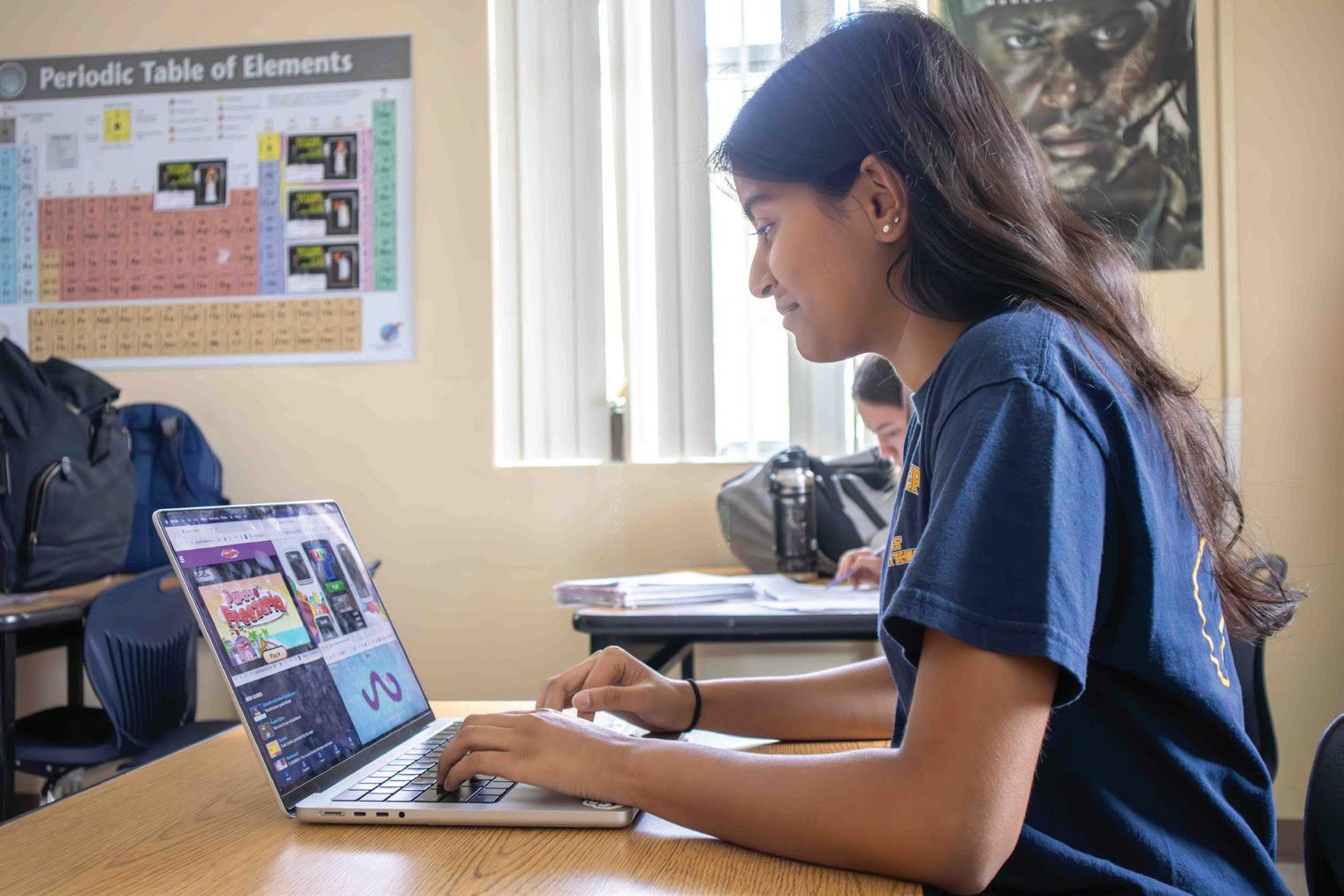
“ ere’s a ton of different games that you can play on [Google Snake], there’s different game modes, you can change the color of your snake, the size and the fruit that your snake is eating,” freshman Campbell Alch said. “It just really captures my attention.”
e attraction to online games goes beyond the colorful graphics and customization. e structure of these games creates a reward system for the brain that is directly connected to the amount of dopamine in the brain, tempting students to play it everyday.
ademic validation or sports validation in turn to find validation and a release of dopamine at the completion of each level. Students often play these games instead of taking notes because it is a quick way to achieve the feeling of accomplishment.
e attraction of continuously playing a game over and over again can eventually lead to an addiction. Gaming is not normally thought of as an addiction, but addiction is
However, if used in an educational way, incorporating online games into lesson plans can increase student attention and participation during classes.
A study from the University of Arkansas showed changes in brain activity and increased performance on tests of visual activity in people who had spent one hour playing the video game, League of Legends. Some students could benefit from playing games in class because they are visual learners, and gaming stimulates their brain to help them learn.
“ ere are some games that people would play in school like Cool Math Games,” Alch said.“I think that there are some educational games on there. I just think teachers need to figure out how to use it for teaching. I think playing games really helps ease your mind … and allow it to retain the information that teachers are telling you.”
March 2O24 Focus 2O
Senior Rhea Choskey plays Papa’s Freezeria, Google Snake, Cool Math Games and Tetris. Childhood computer games such as Google Snake have begun to remerge and gain popularity once again.




FEMINISM MOVED BY MEDIA
Article by Mila Taylor
Graphic by Caden Liu
In October of 2017, social media encouraged one of the biggest social movements to this date. #MeToo prompted individuals to gather together to share their sexual assault stories and gain community by using the hashtag. e movement was one of the many waves of feminism, but this time, it was prompted by social media.
Social media has played a huge role in shaping modern feminism, from the powerful #MeToo movement to the “I’m just a girl” trend. Apps like TikTok and Instagram create platforms for modern feminism to educate, spread and thrive. is advocacy has mainly been executed thanks to the large Gen Z presence on social media platforms. Senior Antoni Hawk said she sees social media as used for the most part as a tool to educate audiences. She said that by using platforms like Instagram and Tiktok, she has gained more knowledge and shaped her views on feminism.
“I didn’t think that there were speci c types [of feminism],” Hawk said. “More people are included in the feminist movement than I thought, and it expands to include everybody, and not just a speci c set of people.”
Popular TikTokers like Dylan Mulvaney, who advocates for transgender women’s rights, and Blair Imani who spreads awareness about Black, Muslim, and LGBTQ women, use their platforms to inform audiences about the feminist movement, and the importance of intersectionality. ese communities are shared through social media platforms including Instagram and Youtube, and are an important break from common social media misinformation. Studies show that women are highly underrepresented in media, but social media platforms have become vital in giving women a platform to share their voices.
A study at the Qatar Computing Research Institute found that in nations with large gender inequities in o ine life, women were more likely to have signi cant online presences. In Pakistan speci cally, women on average had more followers on Google+ (25 versus 16) and Twitter (600 versus 222) than men.
e language used in feminist movements has changed drastically since early women’s
su rage movements, including the Gen Z term of “intersectionality” as an essential element of their feminist views. According to the UN Women’s Organization, the term “intersectional feminism” was coined in 1989 by Kimberlé Crenshaw. Social media prompted a spread in education of intersectional feminism, allowing women of all types and backgrounds to have power in sharing their experiences and stories.
“Intersectional feminism centers the voices of those experiencing overlapping, concurrent forms of oppression in order to understand the depths of the inequalities and the relationships



among them in any given context,” website UNWomen.org states.
Other terminology shared by Gen Z like being a “Girls’ Girl” has also been used by education platforms. Being a “Girls’ Girl” is a woman who is always looking out for other women, as de ned by many TikTok in uencers. Sophomore Elizabeth Carlin describes the community that platforms like TikTok provide for women to give out advice, educate and defend other women when needed.
“As a society, people are always trying to shine women in a negative light,” Carlin said. “I think that women actually do a good job of empowering other women, but it’s always a double-edged sword.”
Female empowerment on social media has created a large sense of community, with recent viral videos stemming from awards shows like the Golden Globes, where comedian Jo Koy made sexist jokes about Taylor Swift, and award winning feminist movie, “Barbie.” TikToks emerged after the show aired, criticizing the comedian for insulting many of the most successful women in the room, including Taylor Swift, Greta Gerwig and Margot Robbie.
Similarly to the sense of community created by educational videos on TikTok, emerging trends like “girl dinner,” “girl math,” and even the sound that sings “I’m just a girl” have created large circles of women who can relate to the same things. Feminism has interestingly gone from women ghting to be included in the workforce and to vote, to now women on TikTok embracing femininity and trends that ironically highlight women’s helplessness. Carlin explained how sometimes these trends could be harmful to the feminist movement.
“ e ‘I’m just a girl’ trend is sometimes very harmful,” Carlin said. “It boils down women to just being silly little creatures. ose trends, yes, they’re fun, but they’re also harmful for the image of women.”
Although trends like these remain somewhat harmful to the perception of women, it is important to note that they are participated in ironically. Along with these popular sounds, women on social media have embraced a more feminine look, known as coquette, where bows, light pink colors and soft makeup are embraced. Carlin expressed the importance of not stereotyping feminists, and that feminism includes all women no matter how they express themselves.
“Feminism used to be the su rage movement, it used to be you have to wear pants if you want any control, and I feel like it’s taking it back and making it how we want feminism,” Carlin said, “It’s showing that there’s no real image or what you have to look like to be a feminist and making it more for everyone.”
March 2O24 Focus 21





PARADISE NO MORE
Article by Fay Zhao
Graphic by Caden Liu
Native Hawaiian Keahi Tajon remembers the excitement every summer when his dad took a break from work in the plantation fields to camp on the west side beach of the Big Island in Hawaii. Tajon ran along the vast sunlit beach to play in the clear crystal water, careful not to step on the school of tropical fish weaving through the coral reefs.

It is a common assumption that tourism positively impacts the economy and locals living in Hawaii. However, corporate companies, often from outside of Hawaii, like hotel company Hilton Worldwide, are the forerunners of profits made in this perfect vacation spot.

Many native Hawaiian traditions have been altered or commercialized to attract the attention of tourists. e authentic religion is masked by the falsities and misinformation synthesized for an audience.
Now a massive hotel looms over the same beach, and a sea of tourists crowd the space with their plastic chairs and umbrellas. e fish have fled, the corals are withered and all signs of native life are overpowered by the mob of tourists.
“I remember a very vibrant coral reef, I remember trees being there, which later on, were cut for firewood,” Tajon said. “I haven’t really smelled the health of the beach since that time. I watched the reefs die back; I’m watching Hawaii die.”
According to Hawaii Guide, a staggering 5 million people traveled to Hawaii in 2023.
e tourism industry is projected to continue to rise especially after COVID-19. Overtourism is the leading factor in the deterioration of Hawaii and its Native people.
“You’re a tourist,” University of Hawaii associate professor Dr. Kalehua Krug said. “You visit a place, you love it so much. You move here and then you become the invasive species … that’s all part of this idea of traveling to Hawaii and not having a care in the world of what your impact would be.”
“Most of [tourism companies] aren’t based in Hawaii,” Tajon said. “ e owners don’t live in Hawaii. All of those dollars get shipped out to wherever that owner comes from … ey don’t invest that money back into keeping Hawaii.”
eir dominance in the tourism industry outcompetes the businesses run by locals, preventing locals from keeping up with the rising prices of land. According to the Department of Housing and Urban Development, Hawaii is ranked fourth highest in the nation for its rate of homelessness. Fifty-one percent of the state’s homeless are Native Hawaiians.
“ ey’re inflating the price,” Tajon said. “I will never see that kind of money in my life. At every level, we’re being priced out of our own homes.”


Projects built on these purchased lands cause dire environmental problems such as habitat loss, deforestation and water pollution. According to the University of Hawaii, these are all contributing factors to Hawaiian species making up 75% of all extinct species in the United States.
In addition to the environmental effects, Native Hawaiians are struggling to maintain their lifestyles and cultural values.
“Hawaiian people no longer have their land, culture, language, religion or ceremonies,” Krug said. “Barely anything of the culture is left. We are in a space to have to revitalize that.”
“ ere’s a whole fake Hawaiian religion called Huna,” Tajon said.” ey reference some Hawaiian words and claim to be some lineage of a Hawaiian healer. You find pictures of very non-Hawaiian people with non-Hawaiian implements beating Native American drums and singing words to Hawaiian songs that don’t exist anywhere but in their own mind.”
e eagerness of uneducated tourists to experience “Hawaiian culture” fuels companies to continue to spread more misconceptions about Native Hawaiian culture. Many sacred things like the leis and the hula lost their cultural significance in the midst of souvenirs and cultural appropriation.
“ ey’re not going to take that extra step to actually verify how legitimate it is or not,” Tajon said. “... Before you know it, Elvis Presley is more Hawaiian than we are.”
Tourists come ready to relax on their vacation, often forgetting to respect and acknowledge the people living there.

“You think that you deserve to go wherever you want and do whatever you want,” Krug said. “You lose this intrinsic respect that you should have for nature, other cultures and other people.”
e lack of awareness and respect leads to vandalization of sacred lands. Past examples of this include the construction of a irty Meter Telescope on Mauna Kea, a sacred mountain for Native Hawaiians and the rebuilding of Coco Palm Resort over Wailua, the birthplace of Hawaiian kings and queens. Due to the lack

March 2O24 Lifestyles

of resources and numbers, protestors have to pick and choose their battles.
“We find successes in small patches and support those,” Tajon said. “ at’s what keeps our fires burning, a lot of us don’t get depressed and burnt out because those little things that show us we do make a difference.”
While tourism is not going to stop, tourists can be more mindful of their actions and the environment around them. Supporting local businesses and traveling with an open mind are good ways to raise awareness to the preservation of Native Hawaiian culture and land. Some activities include working at a tarot farm, removing invasive species and going on an ecotour.
“What has to take place is repurposing the way that tourists show up here … and understanding the impacts that we’ve all had on the natural landscape,” Krug said.
In order to create a new model where money from tourism sustains locals and Hawaii, shaping the younger generation’s mind with good education is imperative.
ly conscious. At the school where Krug works as principal, kids speak in the native language about the environment and go into nature to love and learn about plants and organisms.
“ ey are getting kids more connected with the ocean and bringing back some of these species that all I did was watch die growing up,” Tajon said. “ ere’s hope. I see the stars of hope.”





Tourism negatively impacts Hawaiian land, culture, and people
is occupied by a consideration for other species of nature and not overly consumed with human need.”

“Everything is about education,” Tajon said. “It’s about the kids, what we call the pua, the flowers of Hawaii. We have a saying, ‘if you plan for one year, plant Kalo (taro), if you plan for 10 years plant Koa (eucalyptus), if you want to plan for 100 years, then teach the children.’”
More programs are implemented to teach students to be culturally and environmental-
rough education and fostering conversations, tourists and people of all kinds can learn about Native Hawaiian culture and apply it towards caring and protecting nature.
“Aloha is that word for love and deep respect,” Tajon said. “Aina is our term for land, the things that feed us. e term Aloha Aina, would mean to love the land and love those things that feed you. It’s that integrity that allows us to then move with spiritual intention as much as physical intention.”
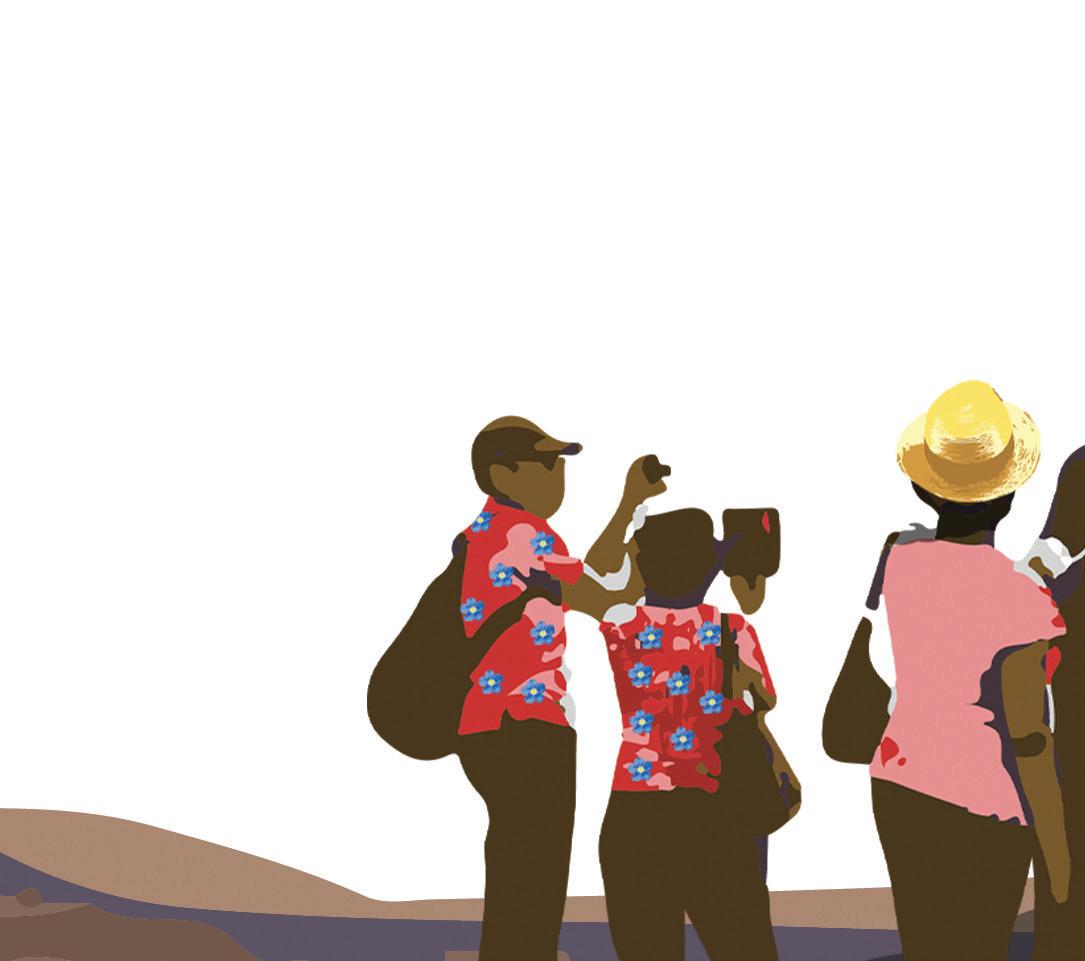

Aligning with this mindset allows people to approach a new place with peace and travel sustainably in a way that is healthy for the world.
“You’ll have this feeling inside that ‘I don’t want to hurt that plant, I don’t want to hurt that fish,’” Krug said. “You’ll be able to balance our human-centric decision making. ere’ll be a space in your mind that
To the Native Hawaiians, it is about modeling their behaviors to the living organisms around them, living in tandem with each other. By taking the time to understand and learn their perspectives, people can become more aware of their own footprints and find solidarity in uniting under an universal cause.
“All the beliefs come from working together from nature,” Krug said. “Watching other species work together and watching plants work together. All these symbiotic relationships are recorded to show that you can not impact one thing without knowing deeply on a spiritual level that it will impact everything.”
At the end of the day, it is the community, unified under the same love and passion, that people like Tajon and Krug fight for. It is the community and home that the Native Hawaiians and the rest of the world can not lose; it is something that is priceless.

“For me it’s community and family everywhere,” Tajon said. “In a world where it’s becoming harder to find safety and integrity, my groups have nothing but safety. We might be broke, but we’re going to eat well, we’re going to sleep well and we’re going to love each other. at to me is a peace of mind, I don’t think anybody with that amount of money can buy.”

March 2O24 Lifestyles


CONSUMER CUP CRAZE
The explosion of reusable water bottles underscores rampant consumerism
Article by Zach Kleiman Graphic by Caden Liu
In a frenzy of flying elbows and frantic shoving, contenders were trampled amidst the chaos. After a long-worn battle, a select few emerged victorious, raising their Stanley Cup in triumph. e cup – not the trophy awarded to the winner of the National Hockey League, but a $45 limited edition Valentine’s Day release exclusively found at Target – would sell for five times its retail price mere hours later.
is rampage in El Paso, Texas is not an isolated incident. Highly sought after and regularly sold out across America, Stanley Cups have become the epitome of modern hydration, blending the relationship between accessibility and fashion.
Founded 111 years ago, Stanley 1913 originally provided reusable insulated beverage containers to American, male blue-collar workers and those participating in outdoor activities. Over a century later, in 2017, its rugged image and consumer demographic underwent a drastic metamorphosis.
Small blogs and influencers introduced the Stanley Cup to mainstream social media platforms, where they would promote the bottle to consumers as part of Stanley’s affiliate program. e strategy worked, as, according to Forbes, the product amassed over seven billion individual impressions on TikTok alone.
Capitalizing on this sudden digital success, Stanley parlayed the release of its top-selling 40-ounce Quencher into a self-reported $750 million in revenue in 2023, up from $73 million in 2019.


and toward avid online shoppers, particularly women. Gearing their marketing strategy towards this new audience, Stanley introduced cups with vibrant colors and positioned itself as an affordable, non-luxury fashion statement.
Since then, it has garnered a cult-like following among women of all ages, permeating realms ranging from Facebook Group Chats to high school classrooms.
“I came here last year from Winter Park High School, and I didn’t really know anybody,” Swift said. “ ese cups actually ended up really helping me make friends here, because people would always start conversations with ‘Oh, I like your cup.’”
While the cups offered camaraderie for Swift, others are drawn to their exclusivity. Commonly purchased as collectors’ items, Stanley offers dozens of colors associated with seasonally-timed limited releases that artificially increase the bottles’ demand, further enhancing their allure. Despite Stanley’s decision to provide a lifetime warranty for all of its hydration products, this strategic approach has not only sustained but also bolstered Stanley’s market value over time.
“Limited edition products signal high quality, so people are not buying one [water bottle], they’re buying five, 10, 15 different colors to display on the shelf,” Krishnamoorthy said. “But if you buy ten different bottles because they have 10 unique colors, that defeats the
purpose of reusable water bottles.”
According to a study conducted by Nestlé, it takes between 10 to 20 uses of a reusable steel water bottle to offset the environmental impact associated with its production. However, in the case of Stanley Cups, since many consumers primarily use them as a collectable and fashion item rather than utilizing them for their intended purpose, their contribution to environmental sustainability remains minimal.
To combat this, Stanley recently committed to make at least 50% of its stainless steel products from recycled materials by 2025. However, the effects of this change may be null and void, as the surge in popularity of the cups has spurred the production of environmentally harmful accessories. ese additions, including plastic lids and sleeves, contribute to increased plastic consumption and environmental degradation.
“ e notion of greenwashing is prevalent here,” Krishnamoorthy said. “Companies know that there is value in presenting as environmentally-conscious as possible to appeal to the consumer, even when they are not.”
is facade presented itself as difficult to maintain after increasingly viral social media posts recently suggested trace amounts of lead were infused in Stanley Cups during the production process. While Stanley received negative publicity from this bombshell, consumers did not halt in their never-ending thirst to acquire the products.


“It’s not a water bottle anymore,” University of Central Florida Associate Professor of Marketing Anand Krishnamoorthy said. “It’s become a fashion statement.”
In adapting to a broader consumer market, Stanley shifted beyond the typical male blue-collar worker




acquire





As fashionable water bottles continue to reach new heights of popularity, their pervasiveness in the face of cyclical trends and questions regarding their intrinsic value are at the forefront of consumers’ minds.

“If everybody’s carrying a Stanley around, why should anybody carry one at all?” Krishnamoorthy said.
March 2O24 Lifestyles 24


NO SUPPORT FROM YOUNG COHORT
Young voters experience discontent with presidential candidates
Article by Tavish Ward
Graphic by Lia Garibay
Childhood can be bittersweet, and while it is di cult to look back at the blissful moments without some sense of nostalgia, progressing into maturity and leaving behind parts of adolescence is necessary. Yet there are some gures that have become shadows throughout our youth, and once again are making an appearance at the polls in 2024. e vast majority of the 21st century, since 2008, has seen in some fashion Joe Biden, Donald Trump, or both, in America’s presidential general elections; becoming pieces of a past that many want to abandon, yet cannot break free from.
appropriately. Whether it be a recession under Trump or massive in ation under Biden, a withdrawal from the Paris Climate Accord under the Republican or record high temperatures under the Democrat, gun violence under one old guy or gun violence under another old guy, it all starts to feel the same.







comes to generational perspectives, there’s not a lot of connectivity,” Eskamani said. “Even when folks try to go online and use these platforms it feels manufactured, it doesn’t feel authentic and I think a lot of young people look for authenticity in civics and in their leaders.”





Discontent has become evident among young people, and a recent survey of over 100 volunteering Trinity Prep students reinforces this conclusion. Among the students who responded as Republicans, under 30% said that they were happy Trump would be the nominee, and among Democrats only 6% were happy Biden was the nominee. Independents and those who don’t identify with a party seemed to be even more frustrated with the two leading candidates, as only 2% were happy with those choices.



ere seems to be signi cant dissatisfaction with candidates handling the issues young voters nd important. One survey taken in 2023 by the Center for Information and Research on Civic Learning and Engagement found that young people’s top issues were the economy, climate change, gun violence and abortion. Recently, there has also been a shift in attentiveness to foreign matters.
While it is true that there are immeasurable di erences between the two presidents, on the surface, without diving deep into the causes, many teens and young adults feel as though neither seem to address any of those issues


In order to start seeing some change in perspectives, Eskamani believes that both politicians and the youth can do a better job listening and having conversations with one another. Social media, while it can be a good way to build connectivity, is also prime for the spread of misinformation, and often people can post or comment without any fact checks.


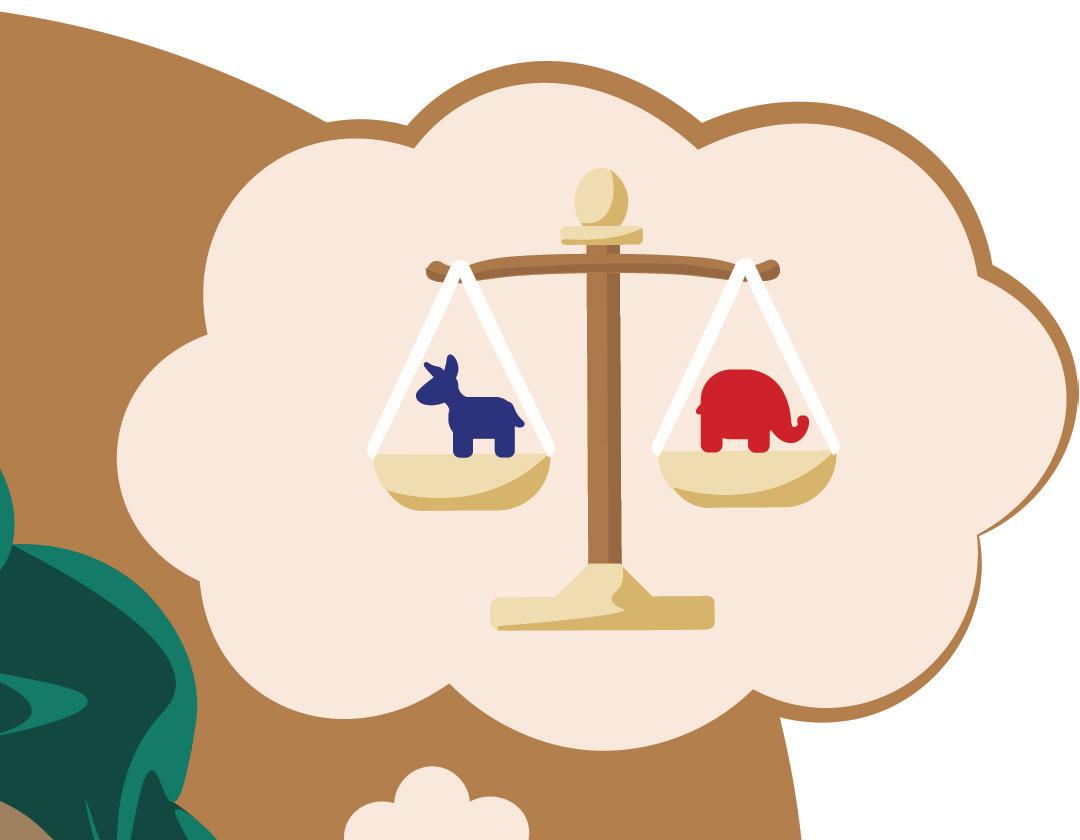











While the responsibility for these problems should not rest solely on the president, many voters place the blame on the person in o ce when these events occurred.
In addition, the 81- and 77-year-old candidates are shockingly not resonating with the youth. Florida State House Representative Anna Esakamani understands that there is a sense of separation between the two very distant generations.
“Both the candidates are seniors, so when it

“With social media, it is so easy to call people out with no consequences and that fuels the lack of dialogue and conversation,” Eskamani said. “But I think that the cials themselves also need to be intentional in talking to young people, hear the criticism and try to lead with change … millennials and Gen Z are two of the largest and most diverse voting blocks in American history.

So don’t take us for granted.”

ose who are of age and intend to arrive at the polls in November, but do not like either of the options available and do not want to go third-party, might be uncertain as to who they will vote for. Eskamani suggests to consider voting for the candidate who you would want across the table if you were ghting for issues you cared about.
“It’s easier to in uence someone that aligns with you on values versus not so,” Eskamani said. “Who’s an easier opponent to persuade on your issues to get them on your side? I think when you frame it like that it can help folks think about it in a di erent way. You’re not always voting for your favorites.”
March 2O24 Lifestyles 25
o


HAYAO MIYAZAKI’S SWAN SONG
A review on Studio Ghibli’s latest: “The Boy and the Heron”
Article by Sammy Lou Poster courtesy of IMDB
In a visually rich display of adventure and coming of age, “ e Boy and the Heron” possibly marks world-famous director and animator Hayao Miyazaki’s nal venture in moviemaking. Miyazaki’s Studio Ghibli dedicated seven years to the making of the movie, which topped the North American box o ce and won a Golden Globe award — a rst for Miyazaki. Miyazaki applied his typical authentic style to create fantastical beings and a magical world straight from a child’s mind.
Set in the closing years of World War II, the lm follows Mahito, an 11-yearold Japanese boy, who has been left scarred and traumatized by the loss of his mother in a hospital re. Shortly after moving to his new stepmother’s countryside estate, Mahito discovers a mysterious, isolated tower nearby with the help of a peculiar, talking heron. Lured by the heron’s promise of reuniting him with his mother, who the heron claims is still alive, Mahito enters the tower and unlocks a supernatural world lled with his family’s secrets.
e best part about watching an animation is that it allows objects, actions and characters never found in the real world to come to life on the screen. e alternate world in this lm is awe-inspiring and demonstrates Miyazaki’s vivid imagination to the fullest. When Mahito enters the magical realm, he encounters a mix of real people and strange, mystical creatures. As he makes his way throughout the world, he ees from evil human-sized parakeets, watches blob-shaped “warawara” spirits ascend to be born on Earth and even discovers a hallway of doors leading to di erent points in time in the real world. roughout Mahito’s adventure, it becomes obvious that the movie leans toward the darker side in terms of visuals, as it deals with more serious themes than some of the other movies that Miyazaki has created.
ese themes, such as growing up and coping with loss and grief, were the part of the lm that resonated the most. Mahito was continuously haunted by visions of his deceased mother throughout the rst half of the movie. However, by the end of the movie, after his mishaps and adventures in the magical world, Mahito demonstrates that he is ready to accept the loss of his mother and also accept his step-
on, especially, is a nuanced, two-sided character that has the viewer pondering about its true nature. e heron’s ability to transform from a graceful, beautiful bird to an ugly humanoid parallels the contrast between the heron’s good intent to guide Mahito along his journey and its deceiving, mischievous personality. e yin and yang of the gray heron also connects with its Japanese cultural signi cance as the symbol of both death and rebirth.

mother into his life. Kenshi Yonezu’s beautiful single “Spinning Globe” which plays during the credits perfectly reinforces the fact that no matter what happens, the beautifully imperfect globe will continue to spin.
It is very apparent that Miyazaki put great care and e ort into crafting the characters, which made the movie all the more captivating to watch. e design and depiction of the her-
Part of what was intriguing about the movie is that the various characters in the movie seem to re ect di erent aspects of Miyazaki himself. e main character of Mahito is, in part, a mirror of Miyazaki’s childhood. Like Mahito, Miyazaki had to evacuate war-torn cities in Japan during WWII and endure di culties at a young age because his mother spent a lot of time in the hospital. Miyazaki also was an introvert as a child, like Mahito. e wizened grand-uncle who is bent on preserving his “perfect,” malice-free world also seems to be a re ection of Miyazaki’s values of innocence and hope for a peaceful world. e resulting autobiographical feel gives the movie emotional depth and a unique glimpse into Miyazaki’s life.
“ e Boy and the Heron” is a masterpiece that was beautifully crafted by a legendary director. If this ends up being Miyazaki’s last movie, it would be a great project to end on, especially because he incorporated parts of his life story into it. If you have enjoyed some of Miyazaki’s other famous lms like “My Neighbor Totoro,” “Spirited Away” or “Howl’s Moving Castle,” I would highly recommend watching e Boy and the Heron when it begins streaming in July. Also, if you decide to watch the English dubbed version, Christian Bale, Willem Dafoe, Florence Pugh and other big names are featured as some of the voice actors. If anything, the tiny “warawara” spirits supply enough cuteness for all audiences to enjoy the movie.
March 2O24 Lifestyles 26




STUDENTS ON THE SPECTRUM
Autism has its struggles but school provides needed community
Article by Sam Miller
Photo by Olivia Prince
In 7th grade, I moved from Minnesota to Florida and found myself in a completely new social environment. at presented me with a challenge many people have gone through: making friends at a new school. But, where others succeeded, nding places they t in and people they connected with, I had a harder time. I struggled to make meaningful relationships, thinking something was wrong with me until the summer of my sophomore year, when I was diagnosed with autism.
According to the CDC, 1 in 36 children in the U.S. are diagnosed with autism. Autism manifests itself di erently in everyone, but there are some common threads. It a ects an individual’s ability to communicate and interact with the world in many ways, most commonly with social interaction. People with autism often have sensory issues like sensitivity to light or sound, do not implicitly understand social rules — like taking turns speaking — and have a hard time learning them. ey might also stim, when one engages in a repetitive motion like tapping ngers or bouncing a leg to calm down in times of stress, or have unusually speci c interests, often called hyper xations.
friends when entering a new school.
“Whenever I go to a new school … I always try to hunt down the weird people because I know that they’ll be more likely to be chill when I’m weird,” Cerruto said. “I don’t try to make myself the same as other people because this is literally something you cannot change about yourself.”
Like many people with autism, Cerruto found her diagnosis validating.
to balance being socially acceptable while also not bottling up all your emotions and pretending to be neurotypical,” said Enzo Cunanan, Trinity alumni and current Oxford student.
Masking can be a useful tool. Autistic traits are frowned upon in some environments so we have to fake the “correct” way to act. Sometimes you limit smaller things like stimming or a lack of eye contact, but some are bigger things like changing how we socialize. Cunanan has had to balance being himself while still following social rules and expectations.
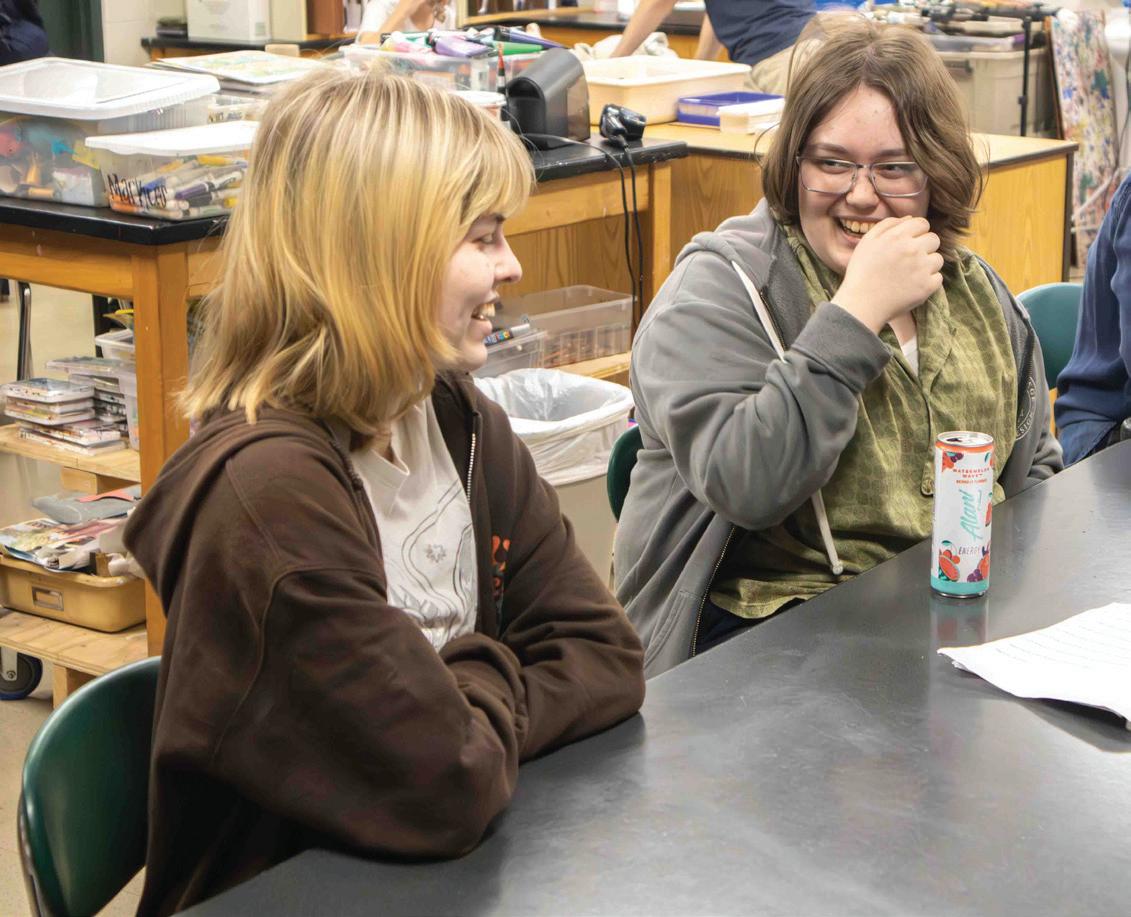
Both in school and outside, it is important for students with autism to nd spaces and communities that won’t judge us for being ourselves, which can be a challenge. A study from psychology researcher Iliana Magiati, who mainly researches autism, showed that people with autism are 27-42% more likely to su er from an anxiety disorder and 23-37% more likely to su er from a depressive disorder due to, among other factors, loneliness.
ere are de nitely ways to combat this loneliness, however. Senior Juno Cerruto, who has autism, has a speci c strategy to nd
“I got diagnosed last summer,” Cerruto said. “Getting a diagnosis really helped. You understand yourself and who you are.”
Even with that understanding there are some coping mechanisms that can be harmful for those on the spectrum. Masking, which is when people on the spectrum suppress parts of their personality to appear more neurotypical, can cause distress. Some unhealthy masking techniques involve changing one’s interests and not coping from stress when needed.
“ e struggle obviously never goes away, but if you’ve learned to think more about it and re ect on yourself, then it becomes a bit easier
“I had this habit of going on rambles about things which no one was interested in except me,” Cunanan said. “I didn’t know when people were politely telling me to stop with whatever I was doing because it wasn’t socially acceptable. I still struggle with that but after something happens I try to replay the incident in my mind.”
It is still important to have spaces to unmask, though. Loneliness is something anyone can help ght. As peers to students with autism, the best thing you can do is be open minded in any interaction and reach out to people who might need a friend. Every student I interviewed noted they had community at Trinity and had resources and help if needed. Cunanan noted he had a great experience at Trinity.
“I was big into history so I was on the quiz bowl team, and I made friends there,” Cunanan said. “My friends at Oxford, some of them are STEM, but most are humanities.”
I have had a good experience as well. After getting diagnosed and learning social skills I lacked, I made some supportive and deep friendships. Trinity has been a community that has helped me and many others grow into who we are today.
March 2O24 Lifestyles 27
Senior Juno Cerruto, who has autism, sits in class with senior Asi Bowman. Community at Trinity has meant a lot to Cerruto.


HARTUNG SERVES UP SUCCESS
Article by Olivia Agnew
Photo by Olivia Kortman
As one of the top women’s tennis players nationally for her age, senior Isabella Hartung has experienced many memorable moments on the court, but nothing compares to winning a doubles tournament with her younger sister at a young age. Even though Hartung had been playing at a higher level, she decided to meet in the middle to compete. Just before the rst match, Hartung was told her racquet was not legal to play with in the new division, so she had to improvise. Hartung ended up playing with a broken racquet and won the nals on her birthday.
is past summer, the Hartung family moved from Davidson, North Carolina to Winter Park, Florida, where Hartung competes for Trinity Pre. Moving away from everything she knew, Hartung was in disbelief.
“I was in denial until I knew that my dad got the new job,” Hartung said. “So I didn’t accept it until three days before we were about to move.”
Although the move was challenging, Hartung has found positives in living in Florida, including the weather, which allows her to play tennis year-round.
“Tennis in Florida, in general, is just so much better,” Hartung said. “ e move is de nitely a lot better for tennis.”
Most of the time, tennis is an individual sport, which adds even more pressure for Hartung as she cannot turn to a teammate for help or support. To most, this would sound intimidating, but for Hartung, competing individually is something she really enjoys.
is happy to be a part of Trinity’s varsity girls tennis team and appreciates the time she gets to spend with her teammates.
Hartung has only been playing with the
very professional and her work ethic is second to none, which has impacted the rest of the girls and made them step up to her level.”
After many years of hard work, Hartung o cially committed to further her academic and tennis career at Bowdoin College in Maine late last year. At rst, Hartung was not excited by Bowdoin, but after visiting and discussing with coaches and family, her decision changed.
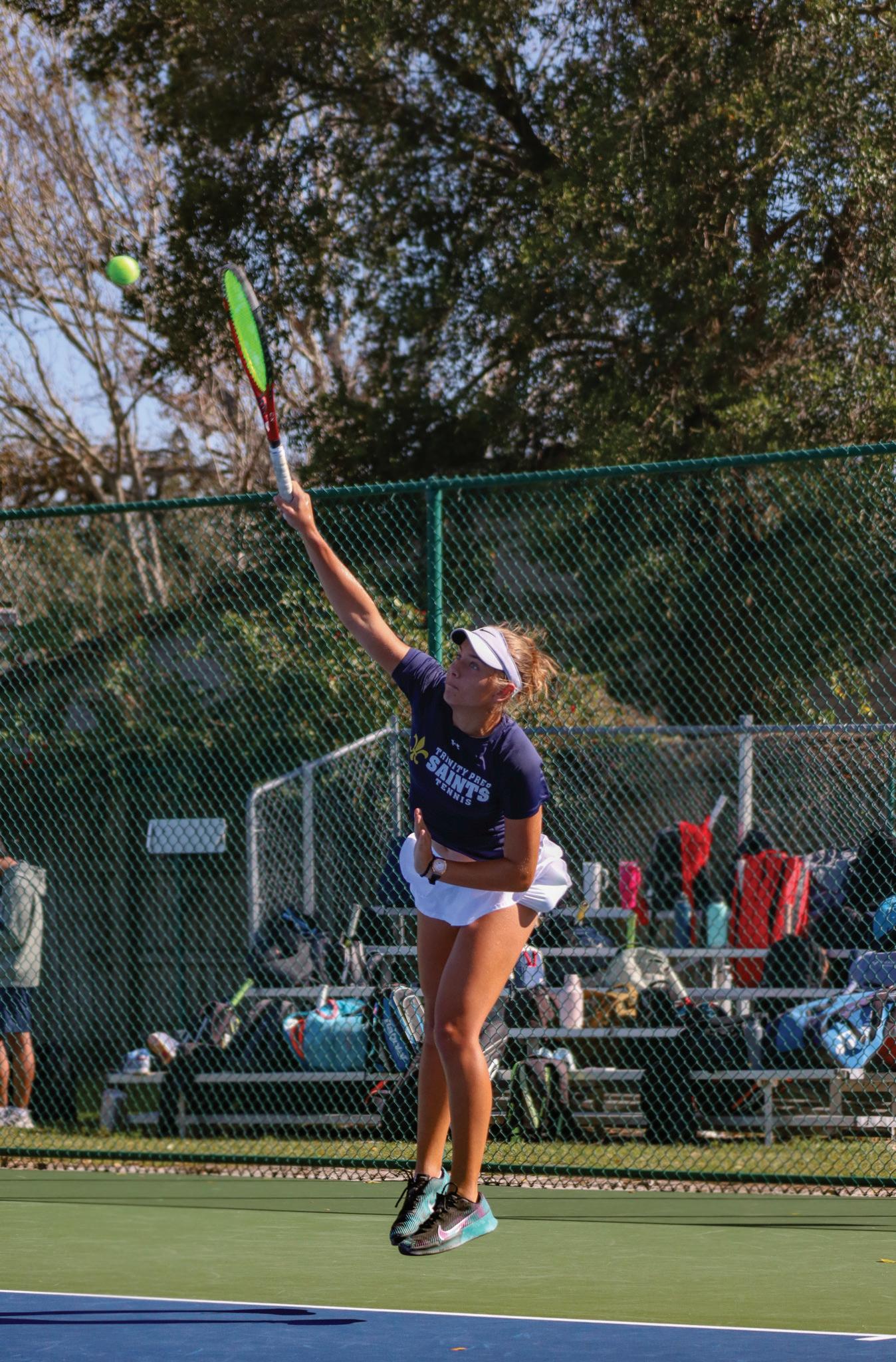
“I [have always] liked playing tennis more than other sports because I didn’t really like being on a team,” Hartung said.
Although Hartung does not always enjoy relying on other players in competition, she
varsity team for a month, but her impact has already helped the team both physically and mentally. Varsity boys and girls tennis coach Martin Harach appreciates her drive and impact on the team.
“[Bella is] just a force of nature for us, she brings a lot of energy,” Harach said. “[She is]
“My dad talked about [Bowdoin] for years, but I was always like no, absolutely not, I don’t want to go to Maine,” Hartung said. “But then they reached out early in October, and I was like, what the heck, I’ll just go on a visit. [After seeing the campus and facilities], I fell in love and committed two days later.”
Hartung has always wanted to play tennis in college, but she also wanted to nd a school that best t her academically. According to a study done by Bowdoin College, Bowdion has an acceptance rate of 9%, giving Hartung the academics she wants.
e recruiting process for college is a stressful task for anyone, Hartung included.
“I was nervous,” Hartung said. “Up until I committed, every tournament was stressful because I knew that coaches could see my results or watch me play.”
Despite being ready for her future at Bowdoin, Hartung’s still has excitement for the nal season of her Trinity tennis carrer. Even though it has only been a few weeks into the season, Harach has high hopes for Hartung individually and the team as a whole.
“Last year we made it to regionals with the girls team, [which we haven’t] done in many years,” Harach said. “ is year, with Bella and other great players, the goal is to [advance] past the regional stage and hopefully get to states.”
March 2O24 Sports 28
Senior Isabella Hartung serving the ball during the match against Lake Highland.

SUCCESSFUL START TO SPRING SPORTS

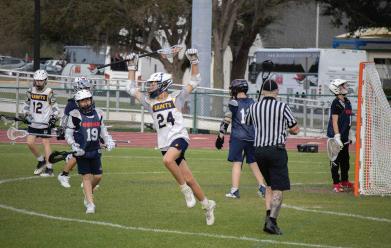

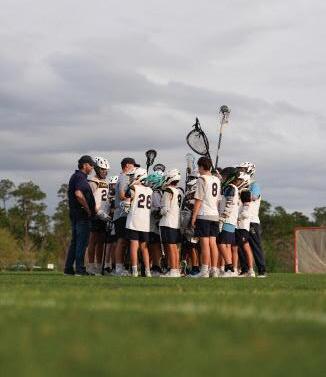
March 2O24 Sports
e boys middle school lacrosse team played its rst home game on March 1, marking the rst middle school game on campus in over four years. Eighth grader Norman Ritterbusch (above) celebrates after scoring a goal in a 5-3 loss to Windermere Prep.
Senior Caden Clifton (above) and junior Lindsey Yared (top left) competed in a track meet at Bishop Moore Catholic on Feb. 23.
Photo by Olivia Kortman
Photo by Olivia Prince
Photo by Jackson Napier
Photo by Olivia Kortman


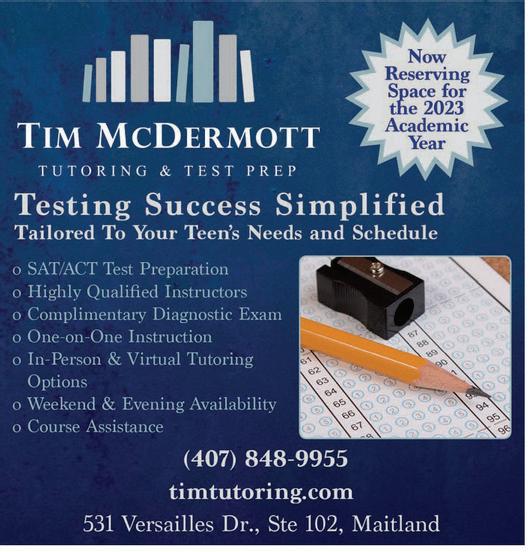




March 2O24 Advertisements 3O

 Puzzles by Karthik Stead & Mila Taylor
Puzzles by Karthik Stead & Mila Taylor





WSYYUJRDOVKNGHL
UBUWQMLEYKFEFYB
DXSACOBRVVIEHLD
QIHKGDHTCOERXMM
NUAHCERPELLGIID
DKMSWOBNIARCSSU
AZRDHUUKLLKCTPH
EPOPLCCIYFHELMW


ACROSS
8. 8-legged Cephalopod
9. Spacecraft used in NASA’s Artemis program to take humans to space.
10. The baseball player who catches balls behind the plate

RJCAAIRTSIGYRMW
BTKQRRNAEMERALD
ASOTGFAFMFQYCTI
DSAUVZZDLUCKMCQ
OPBHSFSEEDKCZSG
SOGMGJQIZVUECEL
NJEFVKRXVHOEERZ









DOWN
1. Where shopping is a pleasure!
2. The part of the neuron covered by the myelin sheath
3. Trinity Prep’s _______ Fest
4. Large seed that grows on Hawaiian trees
7. Author of “A Room of One’s Own”
Answers:









March
2O24 Puzzle 31
WORD BANK
Leprechaun, Clover, Green, Gold, Luck, Irish, Shamrock, Mischief, Rainbows, March, Soda Bread, Patrick, Emerald, Parade
5. Knives, Forks, Spoons, Sporks
6. Taylor Swift’s 6th studio album
Black Panel, Red Panel By Karthik Stead & Taylor Pitone



PHOTOGRAPHY EXPOSITION Life on Campus



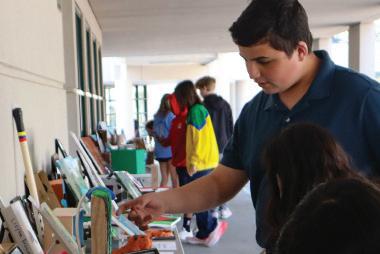
February 2O24 Photos 32
Olivia Kortman
Brayden Kells ‘29 walks through this year’s language world fair on Friday, Feb. 23. e world fair consists of language students’ projects from all around the world.
Jackson Napier
Olivia Kortman
Jackson Altomare ‘25 brings the re to Culture Fest 2024. He participated in the USA booth and grilled hot dogs and burgers.
Olivia Prince
ese middle schoolers posed with the roses during the annual Rose Sale. After selling over 1,000 roses and raising over $2,500, the money went to the Central Florida Coalition for the Homeless.
Victory Hayes ’29 and Gabby Aaron ’29 enjoy the Indian booth at Culture Fest on Feb. 22. e girls were able to try on traditional Indian clothing and jewelry.






























































































 Article by Taylor Gri th
Graphic by Caden Liu
Article by Taylor Gri th
Graphic by Caden Liu




























































































 Puzzles by Karthik Stead & Mila Taylor
Puzzles by Karthik Stead & Mila Taylor

























